Paul van Yperen's Blog, page 170
February 10, 2021
Richard Talmadge
Richard Talmadge (1892-1981) was a German-born actor, stuntman, and film director in Hollywood. Talmadge's fast-pacing action and adventure movies were popular over the world, in particular in the Soviet Union.
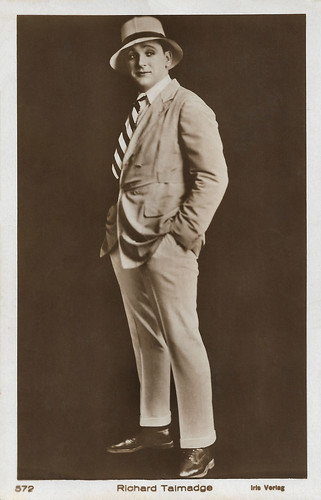
Austrian postcard by Iris Verlag, no. 572. Richard Talmadge in Let's Go (William K. Howard, 1923).
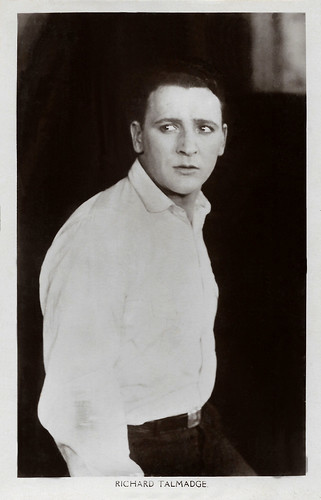
British postcard in the Picturegoer Series, London, no. 140.
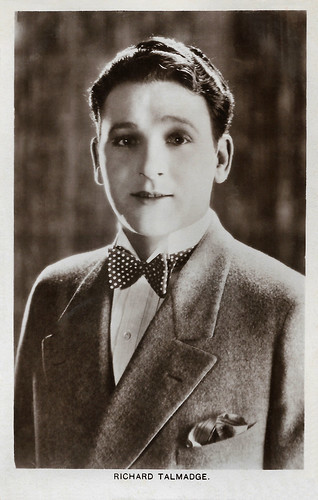
British postcard in the Picturegoer Series, London, no. 140b.
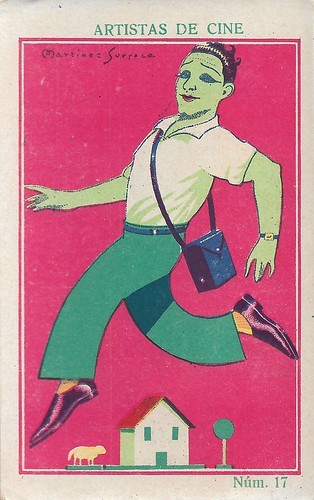
Spanish collectors card by Chocolates Amatller, Barcelona, in the 'Artistas de cine' series, no. 17: Richard Talmadge. Image: Martinez Surroca.
Stuntman for Tom Mix and Douglas Fairbanks
Richard Talmadge was born Sylvester Alphonse Metz, Sylvester Metzetti, Ricardo Metzetti, or Sylvester Ricardo Metzett (the sources differ) in 1892 in Munich, Germany (according to IMDb in Camburg, Saxe-Meiningen (now Thuringia), Germany).
He first came to the USA as a boy member of the famed acrobats, the Metzetti Troupe (also written as Mazetti), that had been engaged by Barnum & Bailey Circus. His brothers, Otto and Victor Metzetti, both had success as stunt performers and were members of the vaudeville troupe the Flying Metzettis (or the Five Metzettis) who were the first to perform the quadruple back somersault in 1917, at Barnum and Bailey's, with Richard as voltigeur.
He arrived in Hollywood in 1910 where he began his career as a stuntman for Slim Summerville, Tom Mix , and Douglas Fairbanks (in such films as The Mark of Zorro, The Three Musketeers, and Robin Hood) before becoming an actor himself. He continued his stunt work after his start as an actor.
Talmadge had his first lead in The Unknown (Grover Jones, 1921) for Phil Goldstone Productions, followed by several more leads in Goldstone films, such as the sensational Thru the Flames (Grover Jones, 1923).
In 1923 Talmadge launched his own company Richard Talmadge productions, starting with Let's Go (William K. Howard, 1923). Other titles were e.g. American Manners (James W. Horne, 1924), Laughing at Danger (James W. Horne, 1924), Tearing Through (Arthur Rosson, 1925), and The Fighting Demon (Arthur Rosson, 1925).
Talmadge's fast-pacing action and adventure films were popular over the world, in particular in the Soviet Union. IMDb : "Talmadge had a large presence in the Soviet market as movies made by independent American producers like Talmadge could be more easily, and cheaply imported. Talmadge's films played only in marginal theaters in the United States (due to the tight control of major theater chains by the large producers), and they enjoyed disproportionate success in the Soviet Union, especially since they were also quite shallow standard fare guaranteed to have no political message. As a result, some films that were barely noticed in their home country became hits in the USSR, their success often at odds with their cinematic value."
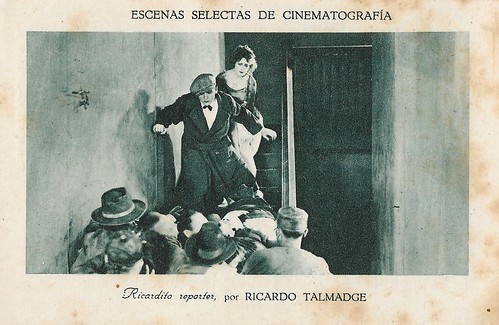
Spanish collector's card in the Escenas selectas de cinematografia series. Photo: Richard Talmadge in The Cub Reporter (John Francis Dillon, 1922), presented in Spain as Ricardo reporter.

Spanish collector's card in the Escenas selectas de cinematografia series. Photo: Richard Talmadge in The Cub Reporter (John Francis Dillon, 1922), presented in Spain as Ricardo reporter.
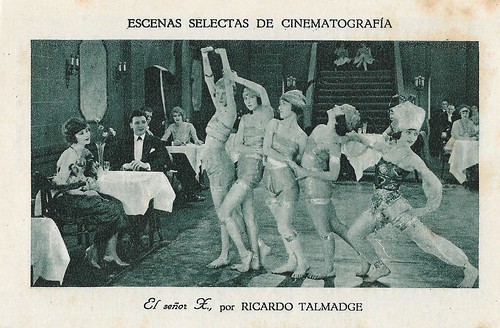
Spanish collector's card in the Escenas selectas de cinematografia series. Photo: El senor X is probably The Mysterious Stranger (Jack Nelson, 1925).
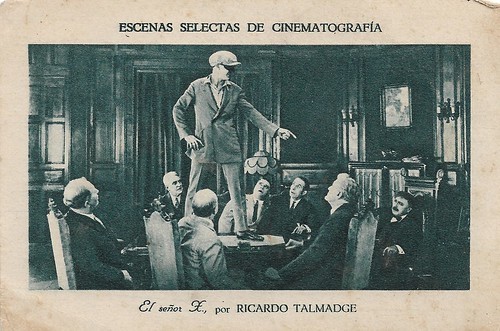
Spanish collector's card in the Escenas selectas de cinematografia series. Photo: El senor X is probably The Mysterious Stranger (Jack Nelson, 1925).
Working behind the cameras
Richard Talmadge was the lead in the Western The Cavalier (Irving Willat, 1928), a film released by Tiffany Pictures with only a music and sound effects soundtrack. He continued with such films as The Poor Millionaire (George Melford, 1930), Dancing Dynamite (Noel M. Smith, 1931), Speed Madness (George Crone, 1932), and the serial Pirate Treasure (Ray Taylor, 1934).
Talmadge never got rid of his German accent, so with the advent of the talkies, he started working behind the cameras as assistant director, stunt coordinator (often uncredited) and, from 1945, as director, thanks to his friend Henry Hathaway.
Talmadge was e.g. assistant-director to Hathaway's North to Alaska (Henry Hathaway, 1960). His later work included stints as the stunt coordinator of How the West Was Won (John Ford, a.o., 1962) and director of the finale of Casino Royale (Ken Hughes, a.o., 1967).
Talmadge was married twice, from 1917 on to Madeleine Francis Allen, and from 1961 till his death in 1981 to Suzanne Avery. He was the stepfather of American polo pioneer and Polo's Grande Dame Sue Sally Hale.
Richard Talmadge died of cancer at the age of 88, in 1981, in Carmel, California. He is interred at Inglewood Park Cemetery, where his grave is marked with the name "Richard Metzetti Talmadge".
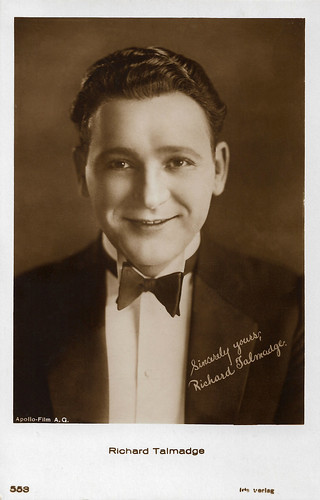
Austrian postcard by Iris Verlag, no. 553. Photo: Apollo Film A.G.
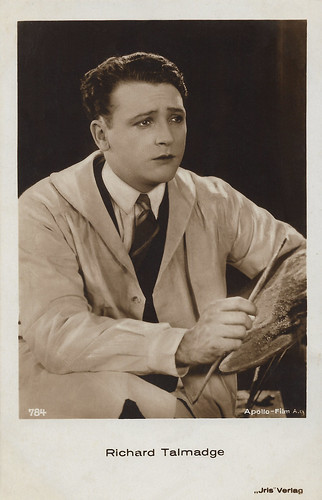
Austrian postcard by Iris Verlag, no. 784. Photo: Apollo-Film A.G.
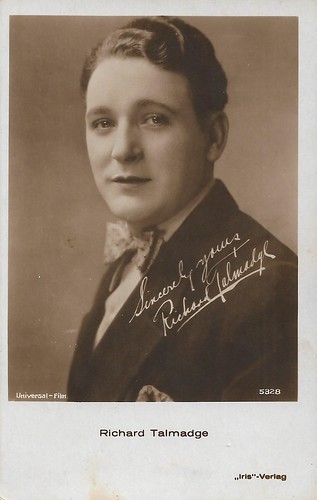
Austrian postcard by Iris Verlag, no. 5328. Photo: Universal-Film.
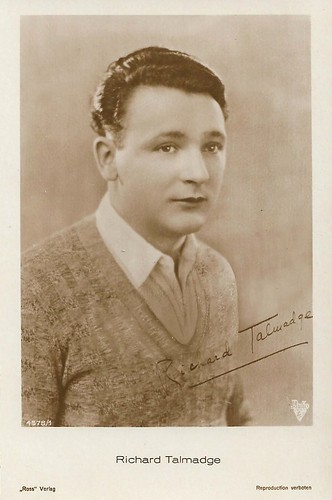
German postcard by Ross Verlag, no. 4578/1, 1929-1930. Photo: Radio Pictures.
Sources: Wikipedia (English and French), and . The Belgian archive Cinematek possesses many Talmadge films.

Austrian postcard by Iris Verlag, no. 572. Richard Talmadge in Let's Go (William K. Howard, 1923).

British postcard in the Picturegoer Series, London, no. 140.

British postcard in the Picturegoer Series, London, no. 140b.

Spanish collectors card by Chocolates Amatller, Barcelona, in the 'Artistas de cine' series, no. 17: Richard Talmadge. Image: Martinez Surroca.
Stuntman for Tom Mix and Douglas Fairbanks
Richard Talmadge was born Sylvester Alphonse Metz, Sylvester Metzetti, Ricardo Metzetti, or Sylvester Ricardo Metzett (the sources differ) in 1892 in Munich, Germany (according to IMDb in Camburg, Saxe-Meiningen (now Thuringia), Germany).
He first came to the USA as a boy member of the famed acrobats, the Metzetti Troupe (also written as Mazetti), that had been engaged by Barnum & Bailey Circus. His brothers, Otto and Victor Metzetti, both had success as stunt performers and were members of the vaudeville troupe the Flying Metzettis (or the Five Metzettis) who were the first to perform the quadruple back somersault in 1917, at Barnum and Bailey's, with Richard as voltigeur.
He arrived in Hollywood in 1910 where he began his career as a stuntman for Slim Summerville, Tom Mix , and Douglas Fairbanks (in such films as The Mark of Zorro, The Three Musketeers, and Robin Hood) before becoming an actor himself. He continued his stunt work after his start as an actor.
Talmadge had his first lead in The Unknown (Grover Jones, 1921) for Phil Goldstone Productions, followed by several more leads in Goldstone films, such as the sensational Thru the Flames (Grover Jones, 1923).
In 1923 Talmadge launched his own company Richard Talmadge productions, starting with Let's Go (William K. Howard, 1923). Other titles were e.g. American Manners (James W. Horne, 1924), Laughing at Danger (James W. Horne, 1924), Tearing Through (Arthur Rosson, 1925), and The Fighting Demon (Arthur Rosson, 1925).
Talmadge's fast-pacing action and adventure films were popular over the world, in particular in the Soviet Union. IMDb : "Talmadge had a large presence in the Soviet market as movies made by independent American producers like Talmadge could be more easily, and cheaply imported. Talmadge's films played only in marginal theaters in the United States (due to the tight control of major theater chains by the large producers), and they enjoyed disproportionate success in the Soviet Union, especially since they were also quite shallow standard fare guaranteed to have no political message. As a result, some films that were barely noticed in their home country became hits in the USSR, their success often at odds with their cinematic value."

Spanish collector's card in the Escenas selectas de cinematografia series. Photo: Richard Talmadge in The Cub Reporter (John Francis Dillon, 1922), presented in Spain as Ricardo reporter.

Spanish collector's card in the Escenas selectas de cinematografia series. Photo: Richard Talmadge in The Cub Reporter (John Francis Dillon, 1922), presented in Spain as Ricardo reporter.

Spanish collector's card in the Escenas selectas de cinematografia series. Photo: El senor X is probably The Mysterious Stranger (Jack Nelson, 1925).

Spanish collector's card in the Escenas selectas de cinematografia series. Photo: El senor X is probably The Mysterious Stranger (Jack Nelson, 1925).
Working behind the cameras
Richard Talmadge was the lead in the Western The Cavalier (Irving Willat, 1928), a film released by Tiffany Pictures with only a music and sound effects soundtrack. He continued with such films as The Poor Millionaire (George Melford, 1930), Dancing Dynamite (Noel M. Smith, 1931), Speed Madness (George Crone, 1932), and the serial Pirate Treasure (Ray Taylor, 1934).
Talmadge never got rid of his German accent, so with the advent of the talkies, he started working behind the cameras as assistant director, stunt coordinator (often uncredited) and, from 1945, as director, thanks to his friend Henry Hathaway.
Talmadge was e.g. assistant-director to Hathaway's North to Alaska (Henry Hathaway, 1960). His later work included stints as the stunt coordinator of How the West Was Won (John Ford, a.o., 1962) and director of the finale of Casino Royale (Ken Hughes, a.o., 1967).
Talmadge was married twice, from 1917 on to Madeleine Francis Allen, and from 1961 till his death in 1981 to Suzanne Avery. He was the stepfather of American polo pioneer and Polo's Grande Dame Sue Sally Hale.
Richard Talmadge died of cancer at the age of 88, in 1981, in Carmel, California. He is interred at Inglewood Park Cemetery, where his grave is marked with the name "Richard Metzetti Talmadge".

Austrian postcard by Iris Verlag, no. 553. Photo: Apollo Film A.G.

Austrian postcard by Iris Verlag, no. 784. Photo: Apollo-Film A.G.

Austrian postcard by Iris Verlag, no. 5328. Photo: Universal-Film.

German postcard by Ross Verlag, no. 4578/1, 1929-1930. Photo: Radio Pictures.
Sources: Wikipedia (English and French), and . The Belgian archive Cinematek possesses many Talmadge films.
Published on February 10, 2021 22:00
February 9, 2021
Olympe Bradna
Brunette leading lady Olympe Bradna (1920-2012) was a French dancer and actress, who danced in Paris, Stockholm, New York City, and other world capitals. In Hollywood, she appeared in more than a dozen films and starred opposite Ronald Reagan, George Raft, and Gary Cooper. In the majority of her films, she played the ornamental love interest to sporting champs or war heroes and had little else to do.
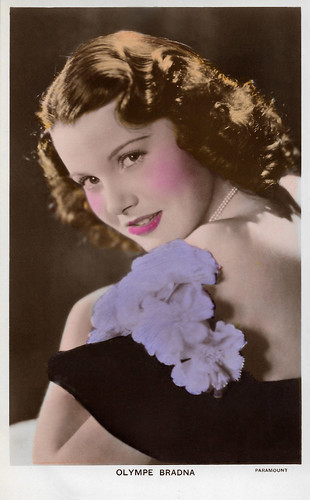
British handcoloured Real Photograph postcard in the Colourgraph Series, London, no. C 399. Photo: Paramount.
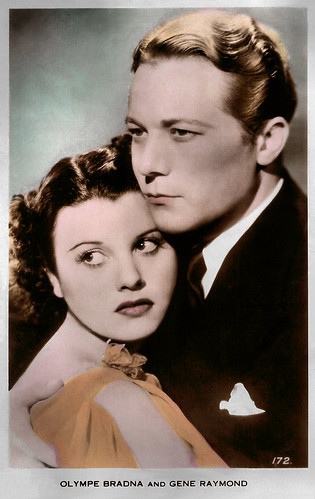
British postcard by Art Photo, no. 172. Photo: Olympe Bradna and Gene Raymond in Stolen Heaven (Andrew L. Stone, 1938).
Born in a dressing room in the Olympia
Antoinette Olympe Bradna was born in 1920 in a dressing room in the Olympia Theatre in Paris, in between a matinée and an evening performance. Her father, Joseph Bradna, was a Bohemian Czech and her mother, Jana Bradna, was Austrian German.
They were circus performers but Jana had been an opera singer before she joined her husband in the circus. Her aunt also was in the circus, as an equestrienne. The dog act of her parents featured at the famous Olympia Theatre - hence her first name.
Trained by her dad, Olympe soon joined the family business, only 18 months of age. By the time she was 8, Bradna "had attracted so much attention that agents were anxious to book her as a 'single'", according to Wikipedia .
Her parents accompanied her to Sweden, Norway, Germany, Switzerland, Italy, and France. She performed an acrobatic dance in a French production of the Broadway musical 'Hit the Deck', billed as the "tiniest sailor in France".
Later she joined the Folies Bergère. She was with that group for eight months and danced at the French Casino in New York City for eight more months.
Olympe Bradna started her film career in France. She made her film debut in the French historical drama Roger la Honte (Gaston Roudès, 1933) starring Constant Rémy, Germaine Rouer , and France Dhélia . It is an adaptation of the 1886 novel of the same name by Jules Mary.
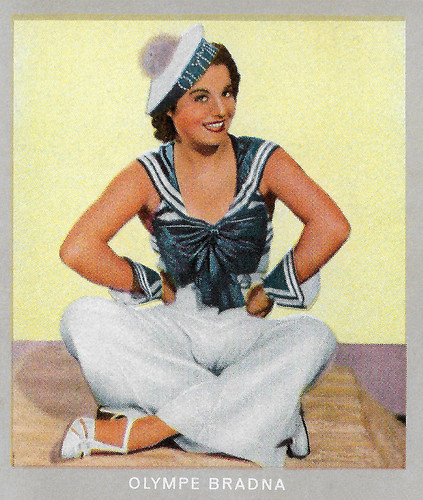
German cigarette card by Ross Verlag in the 'Künstler im Film' series for Zigarettenfabrik Monopol, Dresden, Serie 1, image 146 (of 200). Photo: Paramount.
Pronounce her first name as 'O-lamp'
In 1934, Olympe Bradna joined an American company of the Folies Bergere as an acrobatic dancer for Chicago's World Fair. She then performed for eight months at the French Casino in New York, where she was 'discovered' by Paramount talent scouts and discreetly signed a seven-year contract.
In 1935, she was one of seven young women named by Paramount as possible screen stars of the future. For three months, Olympe was tutored in English, tap dancing, and horse riding.
Her screen debut came in the musical Three Cheers for Love (Ray McCarey, 1936), starring Eleanore Whitney and Robert Cummings. She was introduced by a famous publicity campaign, which instructed prospective American audiences to pronounce her first name 'O-lamp'.
In 1936, she also appeared in the comedy College Holiday (Frank Tuttle, 1936) but according to I.S. Mowis at IMDb "her tiny role was totally submerged by the antics of star comedians Jack Benny, George Burns, Gracie Allen, and Martha Raye."
Later, she branched out from musicals to more serious films and had roles in the war drama The Last Train from Madrid (James P. Hogan, 1937) with Dorothy Lamour and Lew Ayres, and the adventure film Souls at Sea (Henry Hathaway, 1937) with Gary Cooper and George Raft.
Her first leading role was opposite Gene Raymond in Stolen Heaven (Andrew L. Stone, 1938), a forgettable B-film about a couple of jewel thieves on the run. This was followed by the Ray Milland comedy Say It in French (Andrew L. Stone, 1938) and a sentimental theatrical drama, The Night of Nights (1939), which flopped despite a script by Donald Ogden Stewart and directed by Lewis Milestone.
On loan to Warners, she made three more films. In 1941 Olympe married Santa Barbara socialite Douglas Woods Wilhoit, at which point she retired from acting. Her final film was the American war film International Squadron/Flight Patrol (Lewis Seiler, Lothar Mendes, 1941), starring Ronald Reagan.
For many years she and her family lived in Stockton, California, before ultimately settling in Lodi, California. They were married for over seventy years, with Douglas passing away in February 2012, just nine months prior to Olympe's death. Bradna died in 2012, in Stockton, California, at age 92. She was survived by a son, two daughters, five grandchildren, and eight great-grandchildren.
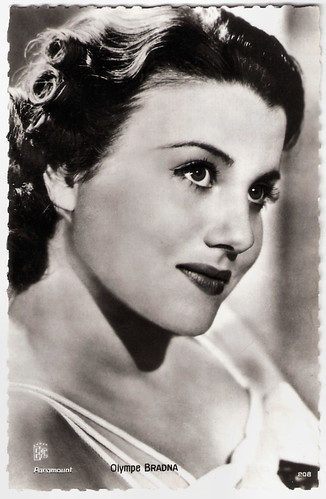
French postcard by EPC, no. 208. Photo: Paramount.
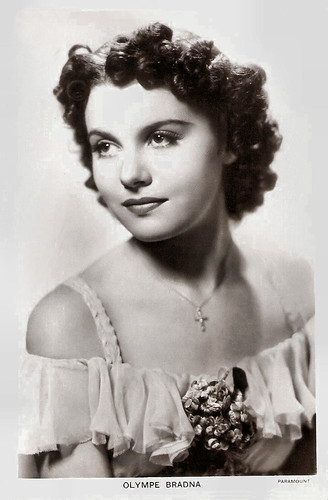
British postcard. Photo: Paramount.
Sources: (IMDb), Wikipedia, and .

British handcoloured Real Photograph postcard in the Colourgraph Series, London, no. C 399. Photo: Paramount.

British postcard by Art Photo, no. 172. Photo: Olympe Bradna and Gene Raymond in Stolen Heaven (Andrew L. Stone, 1938).
Born in a dressing room in the Olympia
Antoinette Olympe Bradna was born in 1920 in a dressing room in the Olympia Theatre in Paris, in between a matinée and an evening performance. Her father, Joseph Bradna, was a Bohemian Czech and her mother, Jana Bradna, was Austrian German.
They were circus performers but Jana had been an opera singer before she joined her husband in the circus. Her aunt also was in the circus, as an equestrienne. The dog act of her parents featured at the famous Olympia Theatre - hence her first name.
Trained by her dad, Olympe soon joined the family business, only 18 months of age. By the time she was 8, Bradna "had attracted so much attention that agents were anxious to book her as a 'single'", according to Wikipedia .
Her parents accompanied her to Sweden, Norway, Germany, Switzerland, Italy, and France. She performed an acrobatic dance in a French production of the Broadway musical 'Hit the Deck', billed as the "tiniest sailor in France".
Later she joined the Folies Bergère. She was with that group for eight months and danced at the French Casino in New York City for eight more months.
Olympe Bradna started her film career in France. She made her film debut in the French historical drama Roger la Honte (Gaston Roudès, 1933) starring Constant Rémy, Germaine Rouer , and France Dhélia . It is an adaptation of the 1886 novel of the same name by Jules Mary.

German cigarette card by Ross Verlag in the 'Künstler im Film' series for Zigarettenfabrik Monopol, Dresden, Serie 1, image 146 (of 200). Photo: Paramount.
Pronounce her first name as 'O-lamp'
In 1934, Olympe Bradna joined an American company of the Folies Bergere as an acrobatic dancer for Chicago's World Fair. She then performed for eight months at the French Casino in New York, where she was 'discovered' by Paramount talent scouts and discreetly signed a seven-year contract.
In 1935, she was one of seven young women named by Paramount as possible screen stars of the future. For three months, Olympe was tutored in English, tap dancing, and horse riding.
Her screen debut came in the musical Three Cheers for Love (Ray McCarey, 1936), starring Eleanore Whitney and Robert Cummings. She was introduced by a famous publicity campaign, which instructed prospective American audiences to pronounce her first name 'O-lamp'.
In 1936, she also appeared in the comedy College Holiday (Frank Tuttle, 1936) but according to I.S. Mowis at IMDb "her tiny role was totally submerged by the antics of star comedians Jack Benny, George Burns, Gracie Allen, and Martha Raye."
Later, she branched out from musicals to more serious films and had roles in the war drama The Last Train from Madrid (James P. Hogan, 1937) with Dorothy Lamour and Lew Ayres, and the adventure film Souls at Sea (Henry Hathaway, 1937) with Gary Cooper and George Raft.
Her first leading role was opposite Gene Raymond in Stolen Heaven (Andrew L. Stone, 1938), a forgettable B-film about a couple of jewel thieves on the run. This was followed by the Ray Milland comedy Say It in French (Andrew L. Stone, 1938) and a sentimental theatrical drama, The Night of Nights (1939), which flopped despite a script by Donald Ogden Stewart and directed by Lewis Milestone.
On loan to Warners, she made three more films. In 1941 Olympe married Santa Barbara socialite Douglas Woods Wilhoit, at which point she retired from acting. Her final film was the American war film International Squadron/Flight Patrol (Lewis Seiler, Lothar Mendes, 1941), starring Ronald Reagan.
For many years she and her family lived in Stockton, California, before ultimately settling in Lodi, California. They were married for over seventy years, with Douglas passing away in February 2012, just nine months prior to Olympe's death. Bradna died in 2012, in Stockton, California, at age 92. She was survived by a son, two daughters, five grandchildren, and eight great-grandchildren.

French postcard by EPC, no. 208. Photo: Paramount.

British postcard. Photo: Paramount.
Sources: (IMDb), Wikipedia, and .
Published on February 09, 2021 22:00
February 8, 2021
Claudio Gora
Italian actor and director Claudio Gora (1913-1998), was already highly active during the war years. From the late fifties, he had a prolific career in Italy in both genre and 'auteur' cinema, often as judges, commissioners, and high-placed military. He acted in 164 films and TV series/plays between 1939 and 1997, while he directed 9 films between 1950 and 1972.
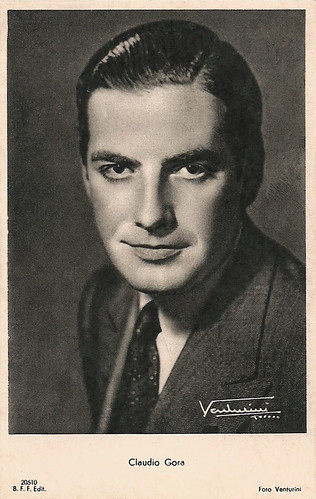
Italian postcard by B.F.F. Edit. (Ballerini & Fratini, Florence), no. 20510. Photo: Venturini.
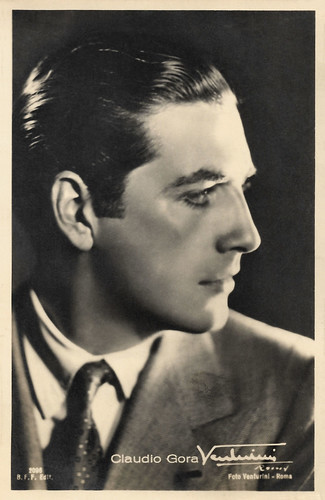
Italian postcard by B.F.F. Edit. (Ballerini & Fratini, Florence), no. 20960. Photo: Venturini.
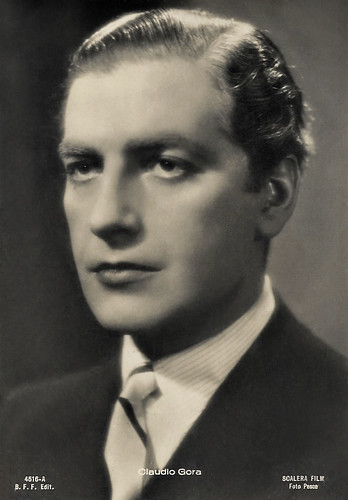
Italian postcard by B.F.F. Edit. (Ballerini & Fratini, Florence), no. 4516-A. Photo: Pesce / Scalera Film.
A courageous investigation of the environment and customs of the new generations
Claudio Gora born Emilio Giordana in Genoa, in 1913. He was the son of the general of the Alpine troops Carlo Felice Giordana (1865-1916).
After graduating in Law, he founded the Teatro Sperimentale Luigi Pirandello in Genoa.
He made his film debut as film actor with Trappola d'amore/Love Trap (Raffaele Matarazzo, 1939). His activity continued with numerous parts as a young actor, including Torna caro ideal/Return Most Beloved (Guido Brignone, 1939), Signorinette/Ladies (Luigi Zampa, 1942) starring Carla Del Poggio , La storia di una capinera/The story of a blackcap (Gennaro Righelli, 1943), Nessuno torna indietro/Nobody goes back (Alessandro Blasetti, 1943, but released in 1945), and Resurrezione/Resurrection (Flavio Calzavara, 1944).
After the war, Gora obtained his first important engagements in Italian-French co-productions such as La Chartreuse de Parme/Charterhouse at Parma (Christian-Jaque, 1947) starring Gérard Philipe , and Marie-Antoinette reine de France/Shadow of the Guillotine (Jean Delannoy, 1956), with Michèle Morgan .
In the meantime, he made his debut as a film director with a demanding job, a film taken from the hit novel by Giuseppe Berto, Il cielo è rosso/The Sky Is Red (Claudio Gora, 1950), starring his wife Marina Berti. It was followed iy Febbre di vivere/Eager to Live (Claudio Gora, 1953), a courageous investigation of the environment and customs of the new generations, based on 'Cronaca', a play by Leopoldo Trieste.
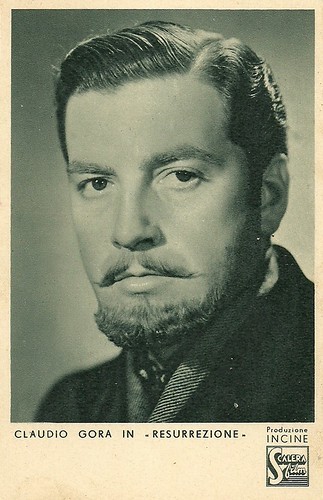
Italian postcard by Zincografica, Firenze. Photo: Produzione Incine / Scalera Film. Claudio Gora in Resurezzione (Flavio Calzavara, 1944), based on Leo Tolstoy's classic novel 'Resurrection' (1899), often adapted to film.
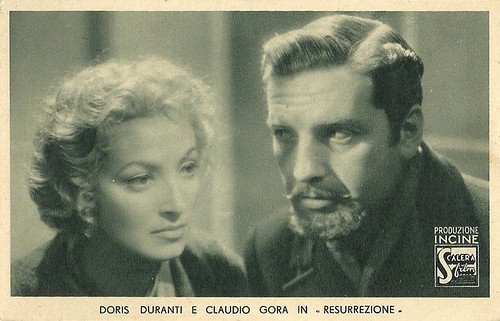
Italian postcard by Zincografica, Firenze. Photo: Produzione Incine / Scalera Film. Claudio Gora and Doris Duranti in Resurezzione (Flavio Calzavara, 1944), based on Leo Tolstoy's classic novel 'Resurrection' (1899), often adapted to film.
The evil Dr. Mabuse
After a gap between 1952 and 1957, Claudio Gora had a most active film acting career from the late 1950s, doing up to 7 films a year in 1960-1961, and often playing magistrates, commissioners, and high-ranked military.
In the late 1950s, Gora acted in historical adventure films such as the blockbuster Il tempesta (Alberto Lattuada, 1958) with Silvana Mangano and Van Heflin, based on Alexander Pushkin's 'Captain's Daughter', and Peplum films such as La Venere di Cheronea/Aphrodite, Goddess of Love (Fernando Cerchio, Viktor Tourjansky, 1957) with Jacques Sernas and Belinda Lee .
Gora also played Remo Banducci, husband of the victim ( Eleonora Rossi Drago ), in Pietro Germi's Un maledetto imbroglio/The Facts of Murder (1959), based on the famous novel by Gadda, 'Quer pasticciaccio brutto de via Merulana'. For this film, he was awarded the Silver Ribbon for supporting actor.
Gora acted in I delfini/Silver Spoon Set (Francesco Maselli, 1960), Adua e le compagne/Hungry for Love (Antonio Pietrangeli, 1960), Via Margutta/Run with the Devil (Mario Camerini, 1960), Tutti a casa/Everybody Go Home! (Luigi Comencini, 1960), and Un amore a Roma/Love in Rome (Dino Risi, 1960), all shot in 1960.
In 1960 Gora himself directed Zsa Zsa Gabor in La contessa azzurra/The blue countess, a film produced by the shipowner Achille Lauro. With Alberto Sordi , Gora played in Una vita difficile/A difficult life (Dino Risi, 1961).
Other important interpretations Gora had in A porte chiuse/Behind Closed Doors (Dino Risi, 1961) with Anita Ekberg , Fantasmi a Roma/Ghosts of Rome (Antonio Pietrangeli, 1961) - one of Belinda Lee 's last films before she was killed in a car crash, Il sorpasso/The Easy Life (Dino Risi, 1962) starring Vittorio Gassman and Jean-Louis Trintignant , and Il processo di Verona/The Verona Trial (Carlo Lizzani, 1963).
He also appeared in ;Il medico della mutua/The Family Doctor (Luigi Zampa, 1968) starring Sordi, Confessione di un commissario di polizia al procuratore della repubblica/Confessions of a Police Captain (Damiano Damiani, 1971), Gente di rispetto/The Masters (Luigi Zampa) and La donna della domenica/The Sunday Woman (Luigi Comencini), the latter both from 1975.
Gora also played evil Dr. Mabuse in the German-Italian co-production Die Todesstrahlen des Dr. Mabuse/I raggi di Dr Mabuse/Dr. Mabuse contra Scotland Yard (Hugo Fregonese, Victor De Santis, 1964), while he also was the police chief in Mario Bava's Diabolik!/Danger: Diabolik (1968), starring John Philip Law. Parallel, Gora had also an active TV acting career, from 1960 onward.
Gora's last film acting part was in one of the typical Christmas comedies, Vacanze di Natale '91/Christmas Vacation '91 (Enrico Oldoini, 1991) with Christian De Sica, Ornella Muti , Alberto Sordi, etc. His last TV part was in La piovra 8 - Lo scandalo/The Octopus 8 - The Scandal (Giacomo Battiato, 1997) with Mario Bova.
Claudio Gora died one year after, in 1998 (age 84) in Rocca Priora, Lazio, Italy. He acted in 164 films and TV series/plays between 1939 and 1997, while he directed 9 films between 1950 and 1972.
Gora was the husband of the actress Marina Berti (1924-2002), whom he met on the set of Storia di una capinera. Gora had five children, all involved in the entertainment world: Andrea, Marina, Carlo, Luca, and Cristina Giordana. Since 2005, the "Claudio Gora Award", an annual competition dedicated to experimental theatre, has been held at the Laboratorium Teatro di Roma.
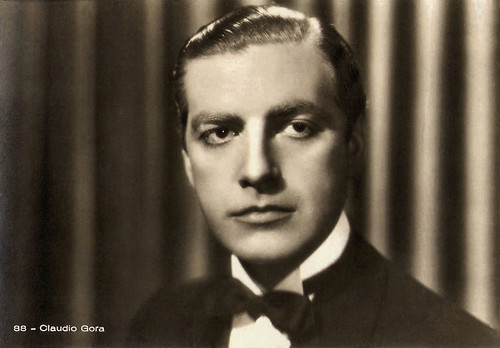
Italian postcard, no. 88.
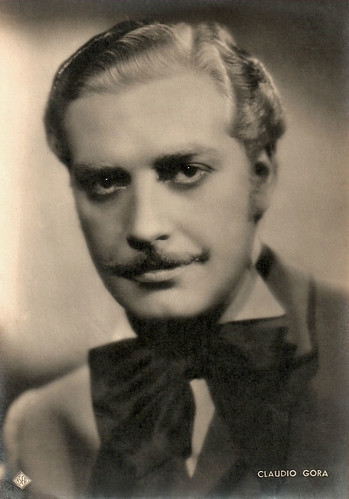
Italian postcard by ASER (A. Scarmiglia Edizioni, Roma), no. 102. Photo: Pesce / SAGFS. Probably for the film Amami, Alfredo! (Carmine Gallone, 1940).
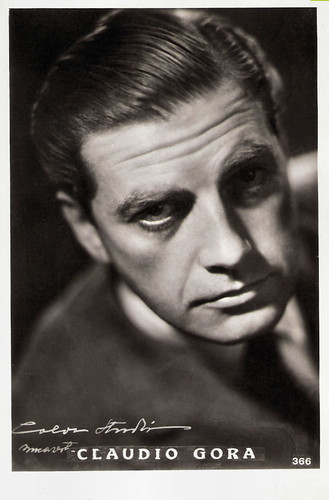
Italian postcard by Stab. Angeli, Terni / A. Terzeli, Roma, no. 366. Photo: Calva Studio.
Sources: , and Wikipedia (Italian and English).

Italian postcard by B.F.F. Edit. (Ballerini & Fratini, Florence), no. 20510. Photo: Venturini.

Italian postcard by B.F.F. Edit. (Ballerini & Fratini, Florence), no. 20960. Photo: Venturini.

Italian postcard by B.F.F. Edit. (Ballerini & Fratini, Florence), no. 4516-A. Photo: Pesce / Scalera Film.
A courageous investigation of the environment and customs of the new generations
Claudio Gora born Emilio Giordana in Genoa, in 1913. He was the son of the general of the Alpine troops Carlo Felice Giordana (1865-1916).
After graduating in Law, he founded the Teatro Sperimentale Luigi Pirandello in Genoa.
He made his film debut as film actor with Trappola d'amore/Love Trap (Raffaele Matarazzo, 1939). His activity continued with numerous parts as a young actor, including Torna caro ideal/Return Most Beloved (Guido Brignone, 1939), Signorinette/Ladies (Luigi Zampa, 1942) starring Carla Del Poggio , La storia di una capinera/The story of a blackcap (Gennaro Righelli, 1943), Nessuno torna indietro/Nobody goes back (Alessandro Blasetti, 1943, but released in 1945), and Resurrezione/Resurrection (Flavio Calzavara, 1944).
After the war, Gora obtained his first important engagements in Italian-French co-productions such as La Chartreuse de Parme/Charterhouse at Parma (Christian-Jaque, 1947) starring Gérard Philipe , and Marie-Antoinette reine de France/Shadow of the Guillotine (Jean Delannoy, 1956), with Michèle Morgan .
In the meantime, he made his debut as a film director with a demanding job, a film taken from the hit novel by Giuseppe Berto, Il cielo è rosso/The Sky Is Red (Claudio Gora, 1950), starring his wife Marina Berti. It was followed iy Febbre di vivere/Eager to Live (Claudio Gora, 1953), a courageous investigation of the environment and customs of the new generations, based on 'Cronaca', a play by Leopoldo Trieste.

Italian postcard by Zincografica, Firenze. Photo: Produzione Incine / Scalera Film. Claudio Gora in Resurezzione (Flavio Calzavara, 1944), based on Leo Tolstoy's classic novel 'Resurrection' (1899), often adapted to film.

Italian postcard by Zincografica, Firenze. Photo: Produzione Incine / Scalera Film. Claudio Gora and Doris Duranti in Resurezzione (Flavio Calzavara, 1944), based on Leo Tolstoy's classic novel 'Resurrection' (1899), often adapted to film.
The evil Dr. Mabuse
After a gap between 1952 and 1957, Claudio Gora had a most active film acting career from the late 1950s, doing up to 7 films a year in 1960-1961, and often playing magistrates, commissioners, and high-ranked military.
In the late 1950s, Gora acted in historical adventure films such as the blockbuster Il tempesta (Alberto Lattuada, 1958) with Silvana Mangano and Van Heflin, based on Alexander Pushkin's 'Captain's Daughter', and Peplum films such as La Venere di Cheronea/Aphrodite, Goddess of Love (Fernando Cerchio, Viktor Tourjansky, 1957) with Jacques Sernas and Belinda Lee .
Gora also played Remo Banducci, husband of the victim ( Eleonora Rossi Drago ), in Pietro Germi's Un maledetto imbroglio/The Facts of Murder (1959), based on the famous novel by Gadda, 'Quer pasticciaccio brutto de via Merulana'. For this film, he was awarded the Silver Ribbon for supporting actor.
Gora acted in I delfini/Silver Spoon Set (Francesco Maselli, 1960), Adua e le compagne/Hungry for Love (Antonio Pietrangeli, 1960), Via Margutta/Run with the Devil (Mario Camerini, 1960), Tutti a casa/Everybody Go Home! (Luigi Comencini, 1960), and Un amore a Roma/Love in Rome (Dino Risi, 1960), all shot in 1960.
In 1960 Gora himself directed Zsa Zsa Gabor in La contessa azzurra/The blue countess, a film produced by the shipowner Achille Lauro. With Alberto Sordi , Gora played in Una vita difficile/A difficult life (Dino Risi, 1961).
Other important interpretations Gora had in A porte chiuse/Behind Closed Doors (Dino Risi, 1961) with Anita Ekberg , Fantasmi a Roma/Ghosts of Rome (Antonio Pietrangeli, 1961) - one of Belinda Lee 's last films before she was killed in a car crash, Il sorpasso/The Easy Life (Dino Risi, 1962) starring Vittorio Gassman and Jean-Louis Trintignant , and Il processo di Verona/The Verona Trial (Carlo Lizzani, 1963).
He also appeared in ;Il medico della mutua/The Family Doctor (Luigi Zampa, 1968) starring Sordi, Confessione di un commissario di polizia al procuratore della repubblica/Confessions of a Police Captain (Damiano Damiani, 1971), Gente di rispetto/The Masters (Luigi Zampa) and La donna della domenica/The Sunday Woman (Luigi Comencini), the latter both from 1975.
Gora also played evil Dr. Mabuse in the German-Italian co-production Die Todesstrahlen des Dr. Mabuse/I raggi di Dr Mabuse/Dr. Mabuse contra Scotland Yard (Hugo Fregonese, Victor De Santis, 1964), while he also was the police chief in Mario Bava's Diabolik!/Danger: Diabolik (1968), starring John Philip Law. Parallel, Gora had also an active TV acting career, from 1960 onward.
Gora's last film acting part was in one of the typical Christmas comedies, Vacanze di Natale '91/Christmas Vacation '91 (Enrico Oldoini, 1991) with Christian De Sica, Ornella Muti , Alberto Sordi, etc. His last TV part was in La piovra 8 - Lo scandalo/The Octopus 8 - The Scandal (Giacomo Battiato, 1997) with Mario Bova.
Claudio Gora died one year after, in 1998 (age 84) in Rocca Priora, Lazio, Italy. He acted in 164 films and TV series/plays between 1939 and 1997, while he directed 9 films between 1950 and 1972.
Gora was the husband of the actress Marina Berti (1924-2002), whom he met on the set of Storia di una capinera. Gora had five children, all involved in the entertainment world: Andrea, Marina, Carlo, Luca, and Cristina Giordana. Since 2005, the "Claudio Gora Award", an annual competition dedicated to experimental theatre, has been held at the Laboratorium Teatro di Roma.

Italian postcard, no. 88.

Italian postcard by ASER (A. Scarmiglia Edizioni, Roma), no. 102. Photo: Pesce / SAGFS. Probably for the film Amami, Alfredo! (Carmine Gallone, 1940).

Italian postcard by Stab. Angeli, Terni / A. Terzeli, Roma, no. 366. Photo: Calva Studio.
Sources: , and Wikipedia (Italian and English).
Published on February 08, 2021 22:00
February 7, 2021
Barbara Nichols
Voluptuous, platinum blonde Barbara Nichols (1928-1976) was an American actress who often played brassy or comic roles in films in the 1950s and 1960s. 'The Queen of the B movies' played strippers, gold-diggers, barflies, gun molls, and other floozy types named Lola, Candy, or even Poopsie.
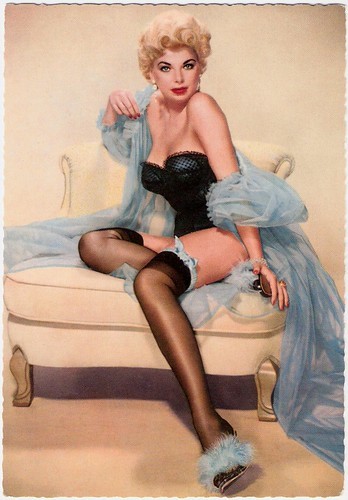
German postcard by ISV, Sort V 16.
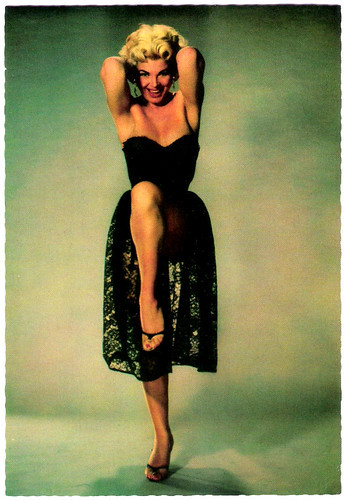
German postcard by ISV, no. 19/6.
The archetypal brassy, bosomy, Brooklynesque bimbo
Barbara Nichols was born Barbara Marie Nickerauer in Mineola, New York, in 1928, to George and Julia Nickerauer. She was raised in Queens, New York.
Early in her career, Nichols was a showgirl. She changed her reddish-brown hair to platinum blonde and drew whistles as a burlesque dancer. When a club owner offered her a much higher salary to become a striptease performer, she declined. She kept her focus on becoming an actress.
Nichols began modeling for cheesecake magazines in the late 1940s and also became a GI pin-up favourite. As a beauty contestant, she won the "Miss Long Island" title as well as the dubious crowns of "Miss Dill Pickle", "Miss Mink of 1953" and "Miss Welder of 1953".
She also began to draw attention in television drama, such as Studio One (1953), The Mask (1954), It's a Great Life (1956), and The Jack Benny Program (1958-1960).
On Broadway, she appeared in a revival of 'Pal Joey' (1952) and she was eventually considered a minor rival to Marilyn Monroe . In the mid-1950s, Barbara Nichols moved to Hollywood and her first part was as a blonde dancer in the Western River of No Return (Otto Preminger, 1954) starring Robert Mitchum and Marilyn Monroe .
She appeared in showy supporting roles in A-films, such as Miracle in the Rain (Rudolph Maté, 1956), the Western The King and Four Queens (Raoul Walsh, 1956) with Clark Gable , and The Naked and the Dead (Raoul Walsh, 1958), based on Norman Mailer's 1948 World War II novel.
Gary Brumburgh at IMDb : "She was the archetypal brassy, bosomy, Brooklynesque bimbo with a highly distinctive scratchy voice. (...) Barbara made the best of her stereotype, taking full advantage of the not-so-bad films that came her way."
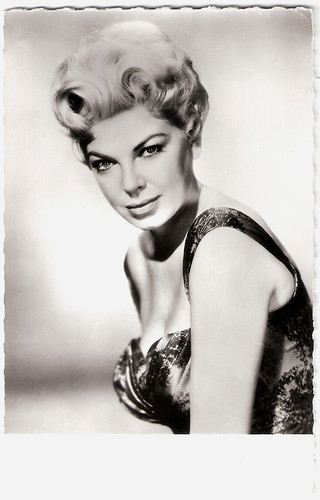
French postcard by Editions P.I., Paris, no. 1066. Photo: Ponti-Girosi / Paramount. Publicity still for That Kind of Woman (Sidney Lumet, 1959).
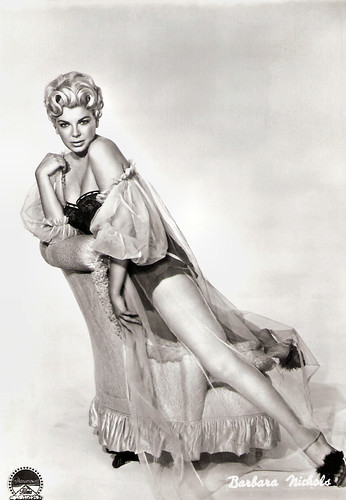
Italian postcard by Bromofoto, Milano, no. 1646. Photo: Paramount. Publicity still for That Kind of Woman (Sidney Lumet, 1959).
She could be very, very funny when let loose
Barbara Nichols appeared in the Film Noir Beyond a Reasonable Doubt (Fritz Lang, 1956) with Dana Andrews and Joan Fontaine. It was the last American film Fritz Lang directed.
Gary Brumburgh at IMDb : "While most of them, of course, emphasized her physical endowments, she could be very, very funny when let loose. By far the best of her lot came out in one year: Pal Joey (George Sidney, 1957), Sweet Smell of Success (Alexander Mackendrick, 1957), and The Pajama Game (George Abbott, Stanley Donen, 1957)."
She also acted in That Kind of Woman (Sidney Lumet, 1958) with Sophia Loren and the comedy Where the Boys Are (Henry Levin, 1960). By the decade's end, though, her film career had hit the skids and she returned to Broadway in 'Let It Ride' (1961).
Nichols turned more and more to television. She was a frequent guest star on many television series, including The Untouchables (1959), The Twilight Zone (1962), The Beverly Hillbillies (1962), Batman (1966), Green Acres (1967), and Hawaii Five-O (1969).
In the cinema, one of her few starring roles was in the Science-Fiction film The Human Duplicators (Hugo Grimaldi, 1965), starring George Nader and Richard Kiel, who played "Jaws" in the James Bond film series. Her final film was Won Ton Ton, the Dog Who Saved Hollywood (Michael Winner, 1976).
Barbara Nichols died in 1976, aged 47, from liver failure due to complications of a damaged spleen and liver reportedly sustained in separate automobile accidents many years earlier. She is interred at Pinelawn Memorial Park in Farmingdale, New York.
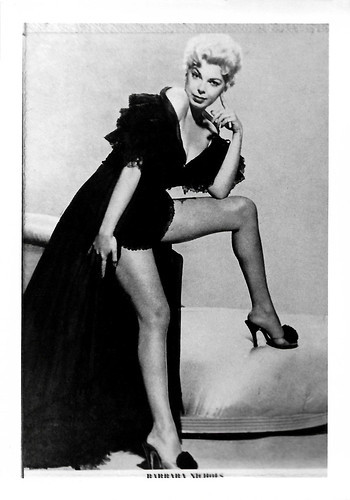
Small Dutch collectors card.
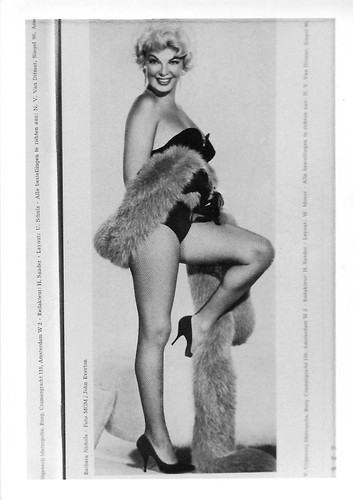
Small Dutch collectors card. Photo: MGM / John Everton.
Sources: (IMDb), Wikipedia, and .

German postcard by ISV, Sort V 16.

German postcard by ISV, no. 19/6.
The archetypal brassy, bosomy, Brooklynesque bimbo
Barbara Nichols was born Barbara Marie Nickerauer in Mineola, New York, in 1928, to George and Julia Nickerauer. She was raised in Queens, New York.
Early in her career, Nichols was a showgirl. She changed her reddish-brown hair to platinum blonde and drew whistles as a burlesque dancer. When a club owner offered her a much higher salary to become a striptease performer, she declined. She kept her focus on becoming an actress.
Nichols began modeling for cheesecake magazines in the late 1940s and also became a GI pin-up favourite. As a beauty contestant, she won the "Miss Long Island" title as well as the dubious crowns of "Miss Dill Pickle", "Miss Mink of 1953" and "Miss Welder of 1953".
She also began to draw attention in television drama, such as Studio One (1953), The Mask (1954), It's a Great Life (1956), and The Jack Benny Program (1958-1960).
On Broadway, she appeared in a revival of 'Pal Joey' (1952) and she was eventually considered a minor rival to Marilyn Monroe . In the mid-1950s, Barbara Nichols moved to Hollywood and her first part was as a blonde dancer in the Western River of No Return (Otto Preminger, 1954) starring Robert Mitchum and Marilyn Monroe .
She appeared in showy supporting roles in A-films, such as Miracle in the Rain (Rudolph Maté, 1956), the Western The King and Four Queens (Raoul Walsh, 1956) with Clark Gable , and The Naked and the Dead (Raoul Walsh, 1958), based on Norman Mailer's 1948 World War II novel.
Gary Brumburgh at IMDb : "She was the archetypal brassy, bosomy, Brooklynesque bimbo with a highly distinctive scratchy voice. (...) Barbara made the best of her stereotype, taking full advantage of the not-so-bad films that came her way."

French postcard by Editions P.I., Paris, no. 1066. Photo: Ponti-Girosi / Paramount. Publicity still for That Kind of Woman (Sidney Lumet, 1959).

Italian postcard by Bromofoto, Milano, no. 1646. Photo: Paramount. Publicity still for That Kind of Woman (Sidney Lumet, 1959).
She could be very, very funny when let loose
Barbara Nichols appeared in the Film Noir Beyond a Reasonable Doubt (Fritz Lang, 1956) with Dana Andrews and Joan Fontaine. It was the last American film Fritz Lang directed.
Gary Brumburgh at IMDb : "While most of them, of course, emphasized her physical endowments, she could be very, very funny when let loose. By far the best of her lot came out in one year: Pal Joey (George Sidney, 1957), Sweet Smell of Success (Alexander Mackendrick, 1957), and The Pajama Game (George Abbott, Stanley Donen, 1957)."
She also acted in That Kind of Woman (Sidney Lumet, 1958) with Sophia Loren and the comedy Where the Boys Are (Henry Levin, 1960). By the decade's end, though, her film career had hit the skids and she returned to Broadway in 'Let It Ride' (1961).
Nichols turned more and more to television. She was a frequent guest star on many television series, including The Untouchables (1959), The Twilight Zone (1962), The Beverly Hillbillies (1962), Batman (1966), Green Acres (1967), and Hawaii Five-O (1969).
In the cinema, one of her few starring roles was in the Science-Fiction film The Human Duplicators (Hugo Grimaldi, 1965), starring George Nader and Richard Kiel, who played "Jaws" in the James Bond film series. Her final film was Won Ton Ton, the Dog Who Saved Hollywood (Michael Winner, 1976).
Barbara Nichols died in 1976, aged 47, from liver failure due to complications of a damaged spleen and liver reportedly sustained in separate automobile accidents many years earlier. She is interred at Pinelawn Memorial Park in Farmingdale, New York.

Small Dutch collectors card.

Small Dutch collectors card. Photo: MGM / John Everton.
Sources: (IMDb), Wikipedia, and .
Published on February 07, 2021 22:00
February 6, 2021
Before Hollywood - Essanay
Today, we start a new series at EFSP: Before Hollywood. Each Sunday, we will post about the early American cinema, its studios, films, and stars. The first post is about the pioneering Essanay Film Manufacturing Company, situated in Chicago. The studio was founded in 1907 as the Peerless Film Manufacturing Company by actress Ruth Stonehouse, G. M. Anderson - who would become Essanay's popular Western hero Broncho Billy, and businessman G.K. Spoor. Essanay ('S and A' for Spoor and Anderson) had its first studio in Chicago but would open the second one in 1912 in Niles, a small town in Alameda County, California, south-east of San Francisco. There, the nearby Western Pacific Railroad route through Niles Canyon proved to be a very suitable location for the filming of Westerns. Essanay is probably best known today for its 1914-1915 series of Charlie Chaplin comedies. In the 1920s, after it had merged with other studios, Essanay was absorbed into Warner Bros.
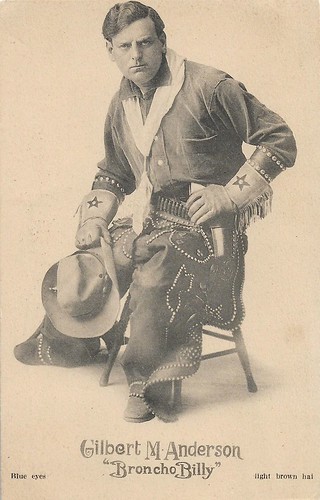
American postcard by Kraus Mfg., Co., New York. Photo: Essanay. Caption: Gilbert M. Anderson (Broncho Billy). Blue eyes light, brown hat.
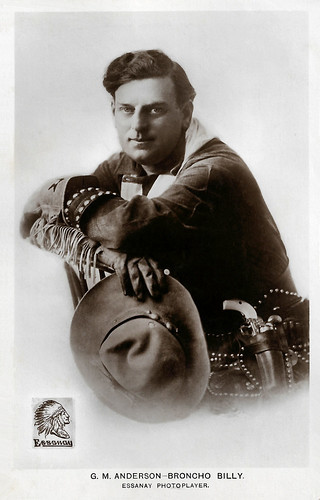
British postcard. Photo: Essanay Film Co.
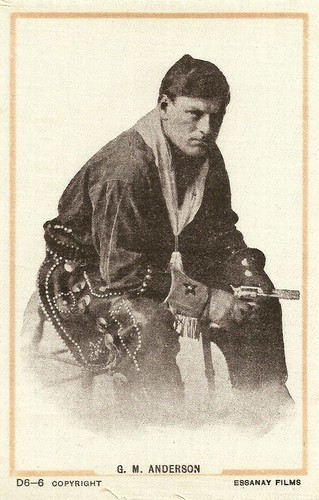
British postcard in the Novelty Series, no. D6-6. Photo: Essanay Films.
American actor, writer, film director, and film producer Gilbert M. 'Broncho Billy' Anderson (1880-1971) was the first star of the Western. Anderson played three roles in the first Western, The Great Train Robbery (Edwin S. Porter, 1903). In 1907, Anderson and George K. Spoor founded Essanay Studios. During the same year, Anderson played Bronco Billy for the first time in The Bandit Makes Good. The film was a great success and Anderson became the first film cowboy star. Anderson directed and starred in almost 400 Broncho Billy films over a seven-year period.
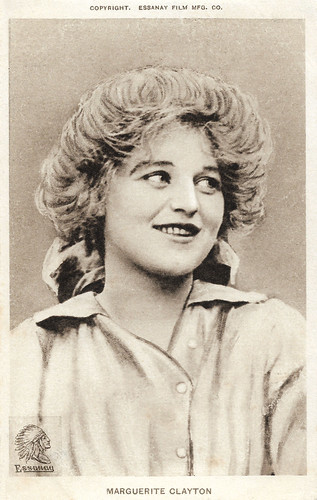
Vintage postcard. Photo: Essanay Film MFG. Co.
American blonde leading lady of early silent films Marguerite Clayton (1891-1968) was best known as Broncho Billy Anderson's perpetual co-star in more than 60 Westerns for Essanay. In 1909, Clayton made her first films, A Mexican's Gratitude and The Heart of a Cowboy, with Broncho Billy Anderson. A Mexican's Gratitude is a one-reel depiction of how Sheriff Anderson saves a Mexican horse thief from death by hanging, the Western was filmed somewhere "beyond the wide Missouri," but Clayton was still Anderson's leading lady when the rustic-looking screen cowboy finally settled in Niles, in 1912. Anderson also cast her in the less strenuous melodramas filmed back in the company's Chicago headquarters. Clayton went freelance in 1917.
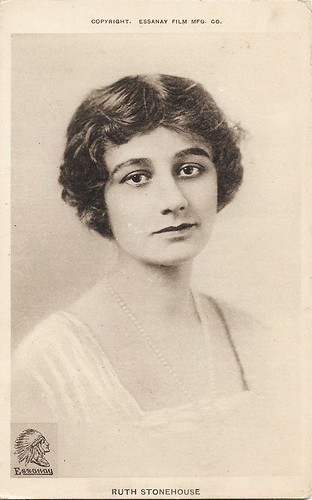
British postcard. Photo: Essanay Film Manufacturing Company.
Ruth Stonehouse (1892–1941) was one of the founding members of the Essanay Film Manufacturing Company in 1907. From 1911, Stonehouse started acting in film at Essanay, first in Mr. Wise, Investigator (E. Mason Hopper, 1911), followed by some 100 short films. Often she would be paired with Francis X. Bushman, as in Neptune's Daughter (Theodor Wharton, 1912). Other regular co-actors at Essanay were e.g. Bryant Washburn, Dolores Cassinelli, Richard Travers, Lilian Drew, and Beverly Bayne. While of many shorts we don't know the directors, some were filmed by directors who would make a career in Hollywood afterward, such as Harry Beaumont and Allan Holubar. Stonehouse almost always had the female lead in these films. In 1916, Stonehouse moved over to Universal.
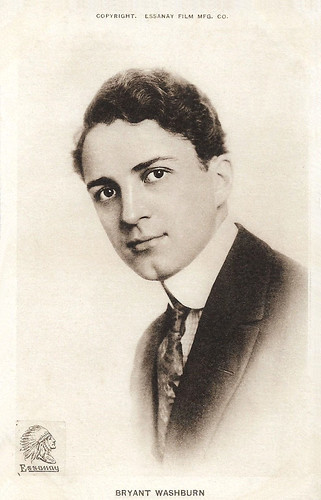
British postcard. Photo: Essanay Film Mfg. Co.
Bryant Washburn (1889–1963) was an American film actor, who appeared in 375 films between 1911 and 1947. From 1911, he was one of the leading actors of the Essanay company. He quickly became a comedy star after appearing in films such as Skinner's Baby and Skinner's Dress Suit in 1917. In 1918 he moved over to Paramount/Famous Players-Lasky.
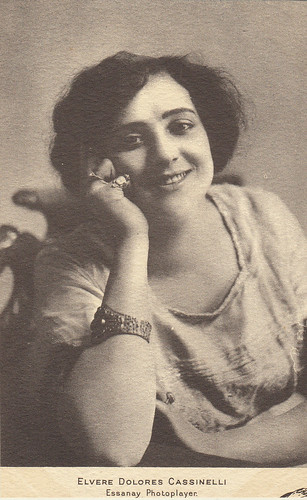
American postcard. Photo: Essanay. Collection: Marlene Pilaete.
Dolores Cassinelli (1888-1984) made her film debut in 1911 at Essanay, where she became one of the leading female stars. She was the leading lady of, among others, Two Men and a Girl (1911), Winning an Heiress (1911), Do Dreams Come True? (1912), Napatia, the Greek Singer (1912), The Laurel Wrath of Fame (1912), When Soul Meets Soul (1913), The Girl at the Brook (1913), The Girl in the Case (1913), A Wolf Among Lambs (1913), and A Successful Failure (1913).
Chaplin’s one year with Essanay was the company's zenith
Essanay's first film was An Awful Skate, or The Hobo on Rollers (1907), starring Ben Turpin, who then worked as the studio janitor. The film was produced for only a couple hundred dollars and grossed several thousand dollars in a release.
The studio prospered and a year later Essanay became a member of the powerful Motion Picture Patents Company. Essanay's famous films include the first American film version of A Christmas Carol (1908) and the first Jesse James movie, The James Boys of Missouri (1908). Essanay also produced the very first American Sherlock Holmes film in 1916 with William Gillette. The first film comedy pie in the face gag is believed to have hit Essanay star Ben Turpin in Mr. Flip (1909).
Essanay produced silent films with such stars as George Periolat, Wallace Beery , Thomas Meighan , Colleen Moore , and Francis X. Bushman. The mainstay of the organisation, however, was studio co-owner, G.M. Anderson, star of the very popular 'Broncho Billy' Westerns.
In November 1914, Essanay lured Charlie Chaplin from Mack Sennett's Keystone Studios. He was paid an unprecedented salary of $1,250 per week, with a bonus of $10,000 for merely signing with the company. Chaplin made 14 short comedies for Essanay in 1915, at both the Chicago and Niles studios, plus a cameo appearance in one of the Broncho Billy Westerns.
The landmark film of the Chaplin series is The Tramp (Charles Chaplin, 1915), in which Chaplin's vagabond character finds work on a farm and is smitten with the farmer's daughter (Edna Purviance). Chaplin injected moments of drama and pathos unheard of in slapstick comedies (the tramp is felled by a gunshot wound, and then disappointed in romance). The film ends with the famous shot of the lonely tramp with his back to the camera, walking down the road dejectedly, and then squaring his shoulders optimistically and heading for his next adventure.
Chaplin disliked the unpredictable weather of Chicago and left after only one year for more money and more creative control elsewhere. His departure caused a rift between founders Spoor and Anderson. Chaplin was the studio's biggest moneymaker, and Essanay resorted to creating 'new' Chaplin comedies from file footage and out-takes. Finally, with Chaplin off the Essanay scene for good, Essanay signed French comedian Max Linder , whose clever pantomime, often compared to Chaplin's, failed to match Chaplin's popularity in America.
Charlie Chaplin ’s one year with Essanay was the company's zenith. Essanay foundered after Chaplin left to join the Mutual Film Corporation. In 1915, the Essanay entered into an agreement, in a last-ditch effort to save the studio, with Vitagraph Studios, Lubin Manufacturing Company, and Selig Polyscope Company to form a film distribution partnership known as V-L-S-E, Incorporated. It was orchestrated by Chicago distributor George Kleine.
Essanay finally ceased operations in 1918. Essanay had produced 1,400 titles during its ten-year history. Of V-L-S-E, only the Vitagraph brand name continued into the 1920s, and was absorbed by Warner Brothers in 1925. Years later, both George K. Spoor (in 1948) and Gilbert M. 'Broncho Billy' Anderson (in 1958) received Oscars, specifically Academy Honorary Awards, for their pioneering efforts with Essanay.
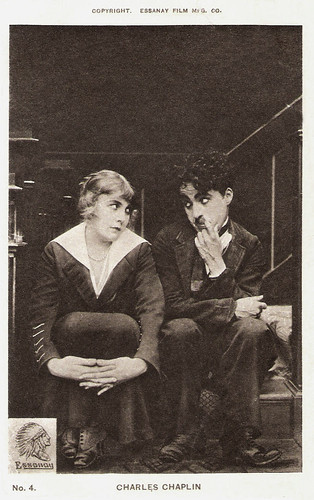
British postcard by Red Letter, no. 4. Photo: Essanay. Charlie Chaplin and Edna Purviance.
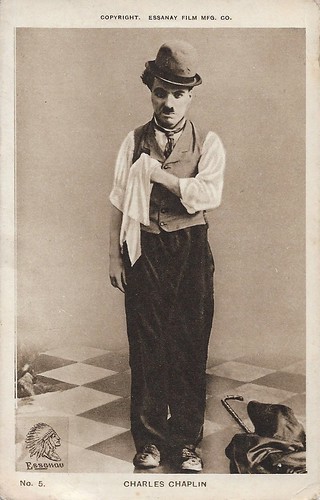
British postcard by Red Letter, no. 5. Photo: Essanay. Charlie Chaplin .
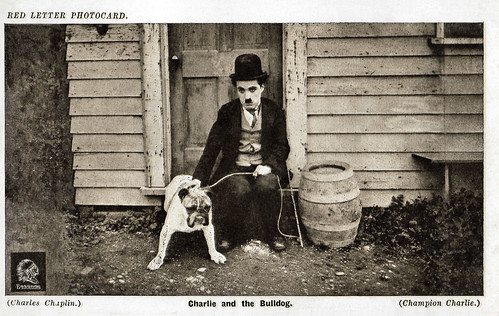
British postcard by Red Letter. Photo: Essanay. Charlie Chaplin in The Champion/Champion Charlie (Charles Chaplin, 1915). Caption: Charlie and the Bulldog.
In 1914, Charles Chaplin signed on at the Essanay Film Manufacturing Company, where he made 15 films. The Essanay comedies find Chaplin in transition, taking greater time and care with each film, experimenting with new ideas, and adding flesh to the Tramp character that would become his legacy. Chaplin’s Essanay comedies reveal an artist experimenting with his palette and finding his craft. In Great Britain, a series of Red Letter photo cards was published with pictures of Chaplin's Essanay films. The titles on the cards are the British film titles.
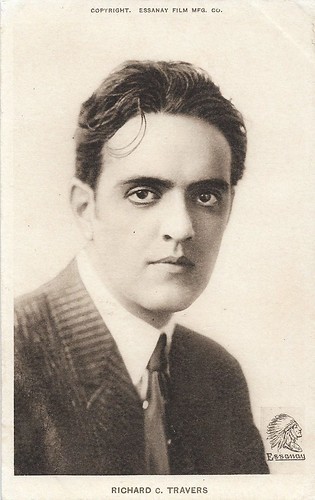
British postcard. Photo: Essanay Film Mfg. Co.
Richard Travers (1885-1935) was a Canadian film actor of the silent era. He appeared in 143 films between 1912 and 1930. In May 1913, Travers was signed to Essanay. He was tapped to play romantic leads and very quickly became a favourite in the studio and among fans. His first big hit for Essanay was The Pay-As-You-Enter Man (1913) and he quickly became an Essanay mainstay. He worked consistently, stationed at the Chicago branch, appearing in 3-reel comedies and other shorts. He played romantic leads but also continued to perform daring, rugged, and athletic roles.

American postcard by Essanay Film Manufacturing Company, Chicago. Photo: The Garraway Company, Rutherford N.J.

Vintage postcard. Photo: Essanay.
American film actor and director Francis X. Bushman (1883-1966) was nicknamed the 'King of the Movies'. Bushman broke into the film business via the stage. At Essanay Studios in Chicago, he was first noticed for his muscular, sculpted frame. His career as a matinee idol started in 1911 in His Friend's Wife. He gained a large female following and became one of the biggest stars of the 1910s.
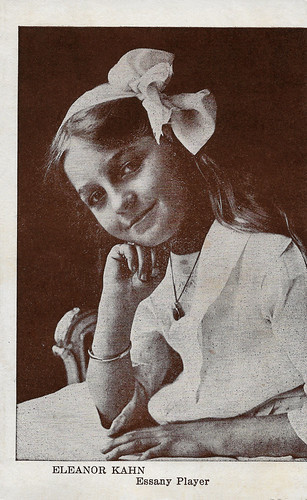
British postcard. Photo: Essanay.
Eleanor Kahn (1903-1982) was a child star of the Essanay studio. She starred in such Essanay productions as The Clown's Baby (N.N., 1911), Her Adopted Father (N.N., 1912), and The Other Girl (E.H. Calvert, 1914) with Francis X. Bushman. Between 1911 and 1915, she appeared in 23 silent films
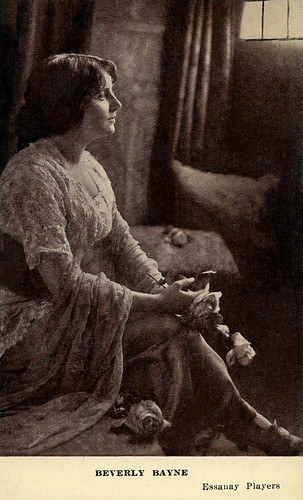
American postcard by Kraus Mfg. Co., N. Y. Photo: Essanay.
American actress Beverly Bayne (1894-1982) was a wide-eyed, brunette star of the early silent cinema. She worked for Essanay in Chicago from 1912. In 1918, she married her co-star, Francis X. Bushman.
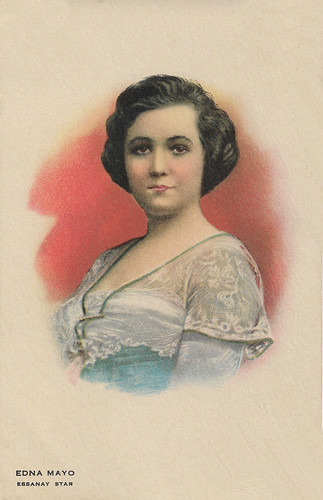
American postcard by Kline Poster Co. Inc., Phila. Illustration: Essanay.
Edna Mayo (1895-1970) was an American actress of the silent film era. She was on stage from 1906 and prominent in films with Essanay between 1914 and 1918.
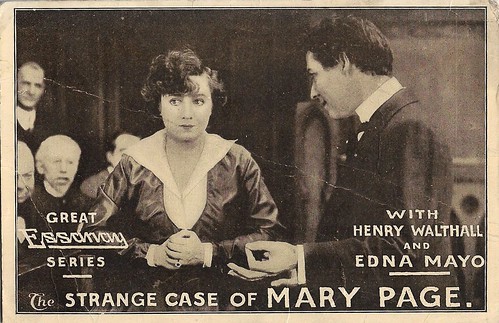
British postcard. Photo: Essanay. Edna Mayo and Henry B. Walthall in the American drama serial The Strange Case of Mary Page (J. Charles Haydon, 1916).
Most of The Strange Case of Mary Page is considered to be lost, with only two of the episodes preserved. The plot deals with an actress, Mary Page (Edna Mayo), suspected of having killed a wealthy, brutal man about town, David Pollock (Sydney Ainsworth). The lawyer who defends her, is her own lover, Philip Langdon (Henry B. Walthall). But is he perhaps the killer too?
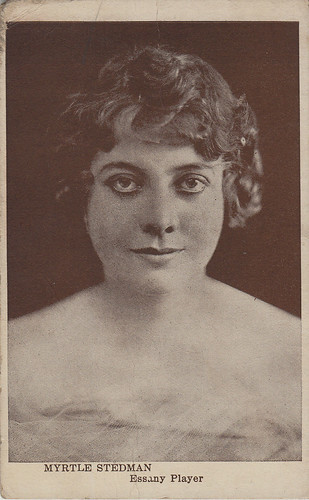
British postcard. Photo: Essanay. Collection: Marlene Pilaete.
American silent screen actress Myrtle Stedman (1885-1938) was known as 'the girl with the pearly eyes'. In 1911, Myrtle and her husband Marshall Stedman were signed by the Selig Polyscope Co. Myrtle was a leading lady in silent films of the 1910s and early 1920s for such companies as Essanay, Bosworth, and Pallas and later, she became a character actress.
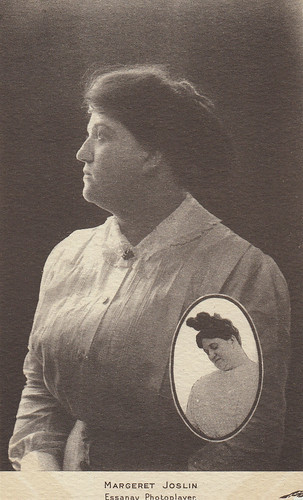
British postcard. Photo: Essanay. Collection: Marlene Pilaete.
Margaret Joslin (1883-1956) was an American film actress who specialised in playing matrons. She appeared in nearly 170 silent films between 1910 and 1923, including many short slapstick comedies starring Harold Lloyd.
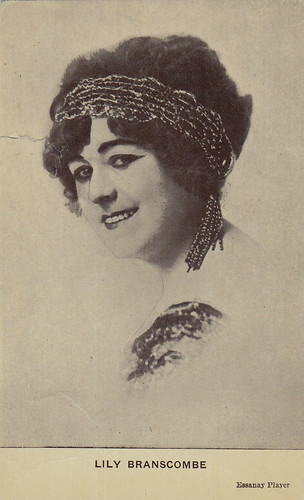
American postcard by Kraus Mfg. Co., N.Y. Photo: Essanay. Collection: Marlene Pilaete.
Brunette Lily Branscombe (1976-1970) was a stage and film actress from New Zealand. She became a beautiful star of the American cinema before Hollywood. Between 1911 and 1913, she played in more than 50 short films for Essanay.
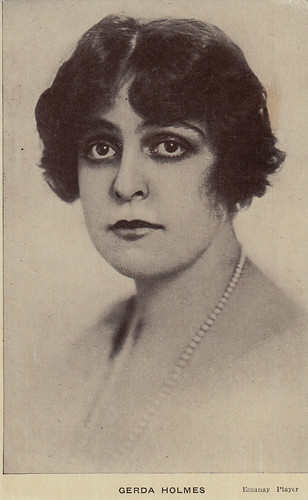
American postcard by Kraus Mfg. Co., N.Y. Photo: Essanay. Collection: Marlene Pilaete.
Gerda Holmes (1891-1943) was a stage actress who also appeared in the silent cinema. She had major roles in numerous films for Essanay including The Fable of Elvira and Farina and the Meal Ticket (1915), and The Iron Ring (1917) with Arthur Ashley. In the 1920s, she became a successful opera singer under her original name of Gerda Henius.
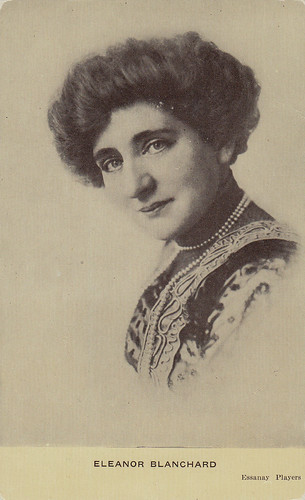
American postcard by Kraus Mfg. Co., N.Y. Photo: Essanay. Collection: Marlene Pilaete.
American actress Eleanor Blanchard (1886-?) appeared in more than a hundred silent films for such companies as Georges Méliès, Essanay, and Lubin.
Sources: Wikipedia and IMDb.
In 2019, we did a post on another pioneering American film studio, the American Vitagraph Company. See also our Essanay album at Flickr.

American postcard by Kraus Mfg., Co., New York. Photo: Essanay. Caption: Gilbert M. Anderson (Broncho Billy). Blue eyes light, brown hat.

British postcard. Photo: Essanay Film Co.

British postcard in the Novelty Series, no. D6-6. Photo: Essanay Films.
American actor, writer, film director, and film producer Gilbert M. 'Broncho Billy' Anderson (1880-1971) was the first star of the Western. Anderson played three roles in the first Western, The Great Train Robbery (Edwin S. Porter, 1903). In 1907, Anderson and George K. Spoor founded Essanay Studios. During the same year, Anderson played Bronco Billy for the first time in The Bandit Makes Good. The film was a great success and Anderson became the first film cowboy star. Anderson directed and starred in almost 400 Broncho Billy films over a seven-year period.

Vintage postcard. Photo: Essanay Film MFG. Co.
American blonde leading lady of early silent films Marguerite Clayton (1891-1968) was best known as Broncho Billy Anderson's perpetual co-star in more than 60 Westerns for Essanay. In 1909, Clayton made her first films, A Mexican's Gratitude and The Heart of a Cowboy, with Broncho Billy Anderson. A Mexican's Gratitude is a one-reel depiction of how Sheriff Anderson saves a Mexican horse thief from death by hanging, the Western was filmed somewhere "beyond the wide Missouri," but Clayton was still Anderson's leading lady when the rustic-looking screen cowboy finally settled in Niles, in 1912. Anderson also cast her in the less strenuous melodramas filmed back in the company's Chicago headquarters. Clayton went freelance in 1917.

British postcard. Photo: Essanay Film Manufacturing Company.
Ruth Stonehouse (1892–1941) was one of the founding members of the Essanay Film Manufacturing Company in 1907. From 1911, Stonehouse started acting in film at Essanay, first in Mr. Wise, Investigator (E. Mason Hopper, 1911), followed by some 100 short films. Often she would be paired with Francis X. Bushman, as in Neptune's Daughter (Theodor Wharton, 1912). Other regular co-actors at Essanay were e.g. Bryant Washburn, Dolores Cassinelli, Richard Travers, Lilian Drew, and Beverly Bayne. While of many shorts we don't know the directors, some were filmed by directors who would make a career in Hollywood afterward, such as Harry Beaumont and Allan Holubar. Stonehouse almost always had the female lead in these films. In 1916, Stonehouse moved over to Universal.

British postcard. Photo: Essanay Film Mfg. Co.
Bryant Washburn (1889–1963) was an American film actor, who appeared in 375 films between 1911 and 1947. From 1911, he was one of the leading actors of the Essanay company. He quickly became a comedy star after appearing in films such as Skinner's Baby and Skinner's Dress Suit in 1917. In 1918 he moved over to Paramount/Famous Players-Lasky.

American postcard. Photo: Essanay. Collection: Marlene Pilaete.
Dolores Cassinelli (1888-1984) made her film debut in 1911 at Essanay, where she became one of the leading female stars. She was the leading lady of, among others, Two Men and a Girl (1911), Winning an Heiress (1911), Do Dreams Come True? (1912), Napatia, the Greek Singer (1912), The Laurel Wrath of Fame (1912), When Soul Meets Soul (1913), The Girl at the Brook (1913), The Girl in the Case (1913), A Wolf Among Lambs (1913), and A Successful Failure (1913).
Chaplin’s one year with Essanay was the company's zenith
Essanay's first film was An Awful Skate, or The Hobo on Rollers (1907), starring Ben Turpin, who then worked as the studio janitor. The film was produced for only a couple hundred dollars and grossed several thousand dollars in a release.
The studio prospered and a year later Essanay became a member of the powerful Motion Picture Patents Company. Essanay's famous films include the first American film version of A Christmas Carol (1908) and the first Jesse James movie, The James Boys of Missouri (1908). Essanay also produced the very first American Sherlock Holmes film in 1916 with William Gillette. The first film comedy pie in the face gag is believed to have hit Essanay star Ben Turpin in Mr. Flip (1909).
Essanay produced silent films with such stars as George Periolat, Wallace Beery , Thomas Meighan , Colleen Moore , and Francis X. Bushman. The mainstay of the organisation, however, was studio co-owner, G.M. Anderson, star of the very popular 'Broncho Billy' Westerns.
In November 1914, Essanay lured Charlie Chaplin from Mack Sennett's Keystone Studios. He was paid an unprecedented salary of $1,250 per week, with a bonus of $10,000 for merely signing with the company. Chaplin made 14 short comedies for Essanay in 1915, at both the Chicago and Niles studios, plus a cameo appearance in one of the Broncho Billy Westerns.
The landmark film of the Chaplin series is The Tramp (Charles Chaplin, 1915), in which Chaplin's vagabond character finds work on a farm and is smitten with the farmer's daughter (Edna Purviance). Chaplin injected moments of drama and pathos unheard of in slapstick comedies (the tramp is felled by a gunshot wound, and then disappointed in romance). The film ends with the famous shot of the lonely tramp with his back to the camera, walking down the road dejectedly, and then squaring his shoulders optimistically and heading for his next adventure.
Chaplin disliked the unpredictable weather of Chicago and left after only one year for more money and more creative control elsewhere. His departure caused a rift between founders Spoor and Anderson. Chaplin was the studio's biggest moneymaker, and Essanay resorted to creating 'new' Chaplin comedies from file footage and out-takes. Finally, with Chaplin off the Essanay scene for good, Essanay signed French comedian Max Linder , whose clever pantomime, often compared to Chaplin's, failed to match Chaplin's popularity in America.
Charlie Chaplin ’s one year with Essanay was the company's zenith. Essanay foundered after Chaplin left to join the Mutual Film Corporation. In 1915, the Essanay entered into an agreement, in a last-ditch effort to save the studio, with Vitagraph Studios, Lubin Manufacturing Company, and Selig Polyscope Company to form a film distribution partnership known as V-L-S-E, Incorporated. It was orchestrated by Chicago distributor George Kleine.
Essanay finally ceased operations in 1918. Essanay had produced 1,400 titles during its ten-year history. Of V-L-S-E, only the Vitagraph brand name continued into the 1920s, and was absorbed by Warner Brothers in 1925. Years later, both George K. Spoor (in 1948) and Gilbert M. 'Broncho Billy' Anderson (in 1958) received Oscars, specifically Academy Honorary Awards, for their pioneering efforts with Essanay.

British postcard by Red Letter, no. 4. Photo: Essanay. Charlie Chaplin and Edna Purviance.

British postcard by Red Letter, no. 5. Photo: Essanay. Charlie Chaplin .

British postcard by Red Letter. Photo: Essanay. Charlie Chaplin in The Champion/Champion Charlie (Charles Chaplin, 1915). Caption: Charlie and the Bulldog.
In 1914, Charles Chaplin signed on at the Essanay Film Manufacturing Company, where he made 15 films. The Essanay comedies find Chaplin in transition, taking greater time and care with each film, experimenting with new ideas, and adding flesh to the Tramp character that would become his legacy. Chaplin’s Essanay comedies reveal an artist experimenting with his palette and finding his craft. In Great Britain, a series of Red Letter photo cards was published with pictures of Chaplin's Essanay films. The titles on the cards are the British film titles.

British postcard. Photo: Essanay Film Mfg. Co.
Richard Travers (1885-1935) was a Canadian film actor of the silent era. He appeared in 143 films between 1912 and 1930. In May 1913, Travers was signed to Essanay. He was tapped to play romantic leads and very quickly became a favourite in the studio and among fans. His first big hit for Essanay was The Pay-As-You-Enter Man (1913) and he quickly became an Essanay mainstay. He worked consistently, stationed at the Chicago branch, appearing in 3-reel comedies and other shorts. He played romantic leads but also continued to perform daring, rugged, and athletic roles.

American postcard by Essanay Film Manufacturing Company, Chicago. Photo: The Garraway Company, Rutherford N.J.

Vintage postcard. Photo: Essanay.
American film actor and director Francis X. Bushman (1883-1966) was nicknamed the 'King of the Movies'. Bushman broke into the film business via the stage. At Essanay Studios in Chicago, he was first noticed for his muscular, sculpted frame. His career as a matinee idol started in 1911 in His Friend's Wife. He gained a large female following and became one of the biggest stars of the 1910s.

British postcard. Photo: Essanay.
Eleanor Kahn (1903-1982) was a child star of the Essanay studio. She starred in such Essanay productions as The Clown's Baby (N.N., 1911), Her Adopted Father (N.N., 1912), and The Other Girl (E.H. Calvert, 1914) with Francis X. Bushman. Between 1911 and 1915, she appeared in 23 silent films

American postcard by Kraus Mfg. Co., N. Y. Photo: Essanay.
American actress Beverly Bayne (1894-1982) was a wide-eyed, brunette star of the early silent cinema. She worked for Essanay in Chicago from 1912. In 1918, she married her co-star, Francis X. Bushman.

American postcard by Kline Poster Co. Inc., Phila. Illustration: Essanay.
Edna Mayo (1895-1970) was an American actress of the silent film era. She was on stage from 1906 and prominent in films with Essanay between 1914 and 1918.

British postcard. Photo: Essanay. Edna Mayo and Henry B. Walthall in the American drama serial The Strange Case of Mary Page (J. Charles Haydon, 1916).
Most of The Strange Case of Mary Page is considered to be lost, with only two of the episodes preserved. The plot deals with an actress, Mary Page (Edna Mayo), suspected of having killed a wealthy, brutal man about town, David Pollock (Sydney Ainsworth). The lawyer who defends her, is her own lover, Philip Langdon (Henry B. Walthall). But is he perhaps the killer too?

British postcard. Photo: Essanay. Collection: Marlene Pilaete.
American silent screen actress Myrtle Stedman (1885-1938) was known as 'the girl with the pearly eyes'. In 1911, Myrtle and her husband Marshall Stedman were signed by the Selig Polyscope Co. Myrtle was a leading lady in silent films of the 1910s and early 1920s for such companies as Essanay, Bosworth, and Pallas and later, she became a character actress.

British postcard. Photo: Essanay. Collection: Marlene Pilaete.
Margaret Joslin (1883-1956) was an American film actress who specialised in playing matrons. She appeared in nearly 170 silent films between 1910 and 1923, including many short slapstick comedies starring Harold Lloyd.

American postcard by Kraus Mfg. Co., N.Y. Photo: Essanay. Collection: Marlene Pilaete.
Brunette Lily Branscombe (1976-1970) was a stage and film actress from New Zealand. She became a beautiful star of the American cinema before Hollywood. Between 1911 and 1913, she played in more than 50 short films for Essanay.

American postcard by Kraus Mfg. Co., N.Y. Photo: Essanay. Collection: Marlene Pilaete.
Gerda Holmes (1891-1943) was a stage actress who also appeared in the silent cinema. She had major roles in numerous films for Essanay including The Fable of Elvira and Farina and the Meal Ticket (1915), and The Iron Ring (1917) with Arthur Ashley. In the 1920s, she became a successful opera singer under her original name of Gerda Henius.

American postcard by Kraus Mfg. Co., N.Y. Photo: Essanay. Collection: Marlene Pilaete.
American actress Eleanor Blanchard (1886-?) appeared in more than a hundred silent films for such companies as Georges Méliès, Essanay, and Lubin.
Sources: Wikipedia and IMDb.
In 2019, we did a post on another pioneering American film studio, the American Vitagraph Company. See also our Essanay album at Flickr.
Published on February 06, 2021 22:00
February 5, 2021
Recently acquired: Ross Verlag XXL
During the 1930s, Ross Verlag in Berlin published film star cards in several formats: you collect postcards in different sizes, but also very small cigarette cards and big cards in an XXL format. These XXL cards were produced in the late 1930s. They were printed in black and white and have no text or lines on the flipside. We recently acquired a series of these cards with glamorous female film stars and starlets. For this post, we selected 12 of these cards.
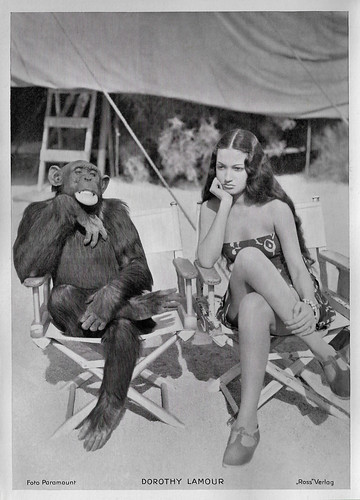
Big German card by Ross Verlag. Photo: Paramount.
American actress and singer Dorothy Lamour (1914-1996) is best remembered for appearing in the Road to... comedies, starring Bing Crosby and Bob Hope. During World War II, Lamour was among the most popular pin-up girls among American servicemen.
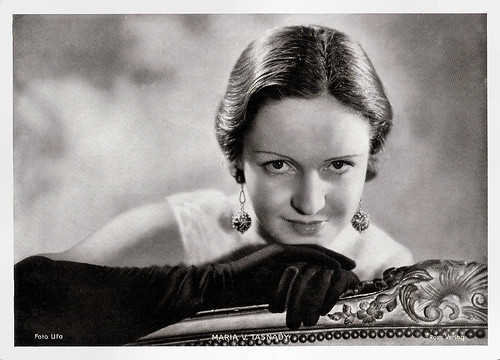
Big German card by Ross Verlag. Photo: Ufa.
Maria von Tasnady (1911-2001) was a Hungarian singer, stage, and film actress.
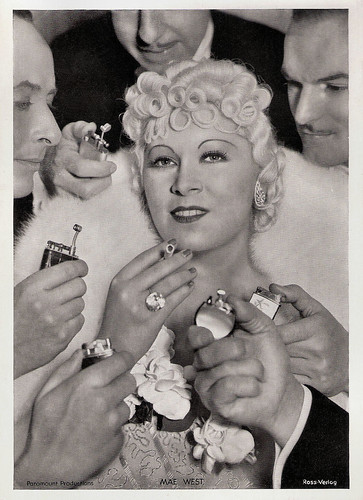
Big German card by Ross Verlag. Photo: Paramount Pictures.
Blonde Mae West (1895-1982) was a seductive, overdressed, endearing, intelligent, and sometimes vulgar American actress and sex symbol. She featured a come-hither voice, aggressive sexuality, and a genius for comedy. West started in Vaudeville and on the stage in New York, and later moved to Hollywood to star in such films as I’m No Angel (1933), She Done Him Wrong (1933), and Klondike Annie (1936). She was one of the first women in the cinema to consistently write the films she starred in.
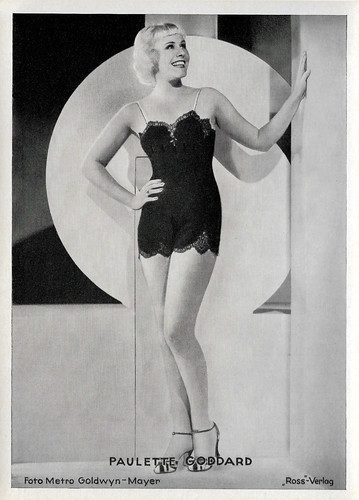
Big German card by Ross Verlag. Photo: Metro-Goldwyn-Mayer.
American actress Paulette Goddard (1905-1990) started her career as a fashion model and as a Ziegfeld Girl in several Broadway shows. In the 1940s, she became a major star of Paramount Pictures. She was Charlie Chaplin's leading lady in Modern Times (1936), and The Great Dictator. Goddard was nominated for an Oscar for Best Supporting Actress for So Proudly We Hail! (1943). Her husbands included Chaplin, Burgess Meredith, and Erich Maria Remarque.
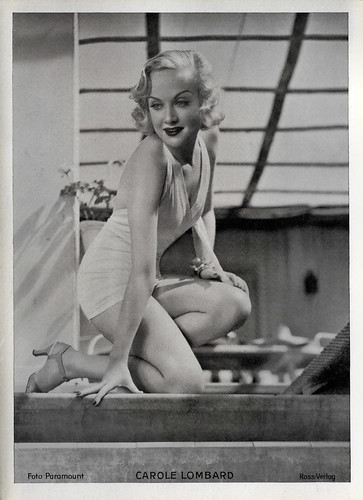
Big German card by Ross Verlag. Photo: Paramount.
American film actress Carole Lombard (1908–1942) was the highest-paid star in Hollywood in the late 1930s. She was particularly noted for her energetic, ditzy, and often off-beat roles in screwball comedies of the 1930s.
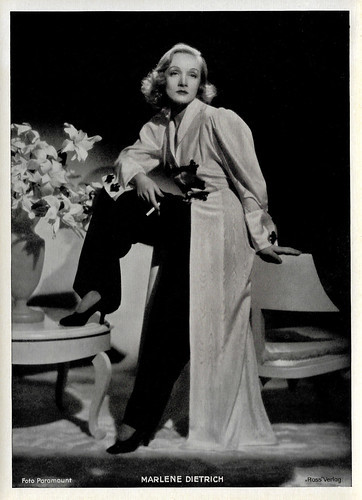
Big German card by Ross Verlag. Photo: Paramount.
Marlene Dietrich (1901-1992) is regarded as the first German actress to become successful in Hollywood. Throughout her long career, she constantly re-invented herself, starting as a cabaret singer, chorus girl, and film actress in 1920s Berlin, she became a Hollywood movie star in the 1930s, a World War II frontline entertainer, and finally an international stage show performer from the 1950s to the 1970s. Eventually, she became one of the entertainment icons of the 20th century.
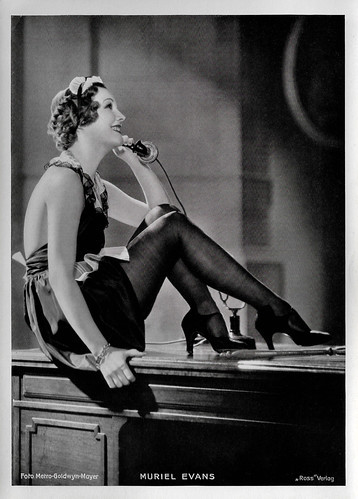
Big German card by Ross Verlag. Photo: Metro-Goldwyn-Mayer.
Lovely, blonde Muriel Evans (1910-2000) was an innocent-eyed actress of the late 1920s and 1930s She was best known for her many appearances in popular B-Westerns alongside Tom Mix, John Wayne, and Buck Jones. For this, she won a Golden Boot Award.
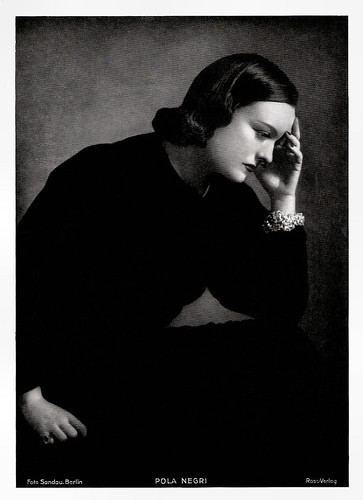
Big German card by Ross Verlag. Photo: Ernst Sandau, Berlin.
Polish film actress Pola Negri (1897-1987) achieved fame and notoriety as a femme fatale in German and American silent films between the 1910s and 1930s. Negri was an overnight sensation in Ernst Lubitsch's Madame du Barry/Passion (1919). She moved to Hollywood where she became a star and lived in a palace, modeled after the White House.
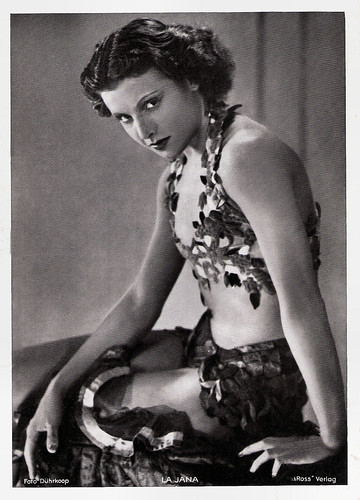
Big German card by Ross Verlag. Photo: Dührkoop.
Sexy German dancer and film actress La Jana (1905-1940) was the most popular showgirl of Berlin in the 1930s. She appeared in 25 European films, often dancing in exotic costumes. In 1940, she suddenly died of pneumonia and pleurisy.
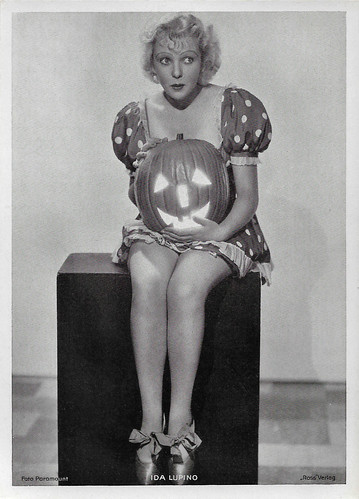
Big German card by Ross Verlag. Photo: Paramount.
Ida Lupino (1918-1995) was an English-American actress and singer, who became a pioneering director and producer—the only woman working within the 1950s Hollywood studio system to do so. With her independent production company, she co-wrote and co-produced several of her own social-message films, and was the first woman to direct a Film Noir, The Hitch-Hiker (1953). In her 48-year career, she acted in 59 films and directed 8, mostly in the United States, where she became a citizen in 1948. The majority of her later career as an actress, writer, and director was in television, where she directed more than 100 episodes of productions ranging across Westerns, supernatural tales, situation comedies, murder mysteries, and gangster stories.
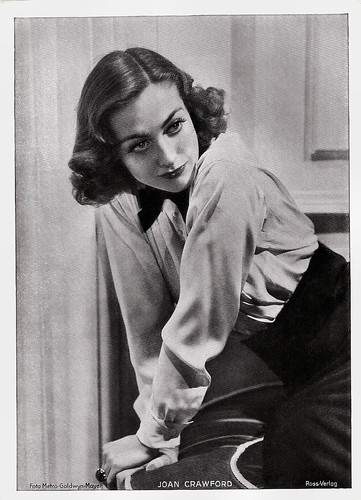
Big German card by Ross Verlag. Photo: Metro-Goldwyn-Mayer (MGM).
American actress Joan Crawford (1905-1977) became nationally-known as a flapper by the end of the 1920s. In the 1930s, her fame rivaled, and later outlasted, MGM colleagues Norma Shearer and Greta Garbo. Crawford often played hardworking young women who find romance and success. These 'rags-to-riches' stories were well received by Depression-era audiences and were popular with women. Crawford became one of Hollywood's most prominent movie stars and one of the highest-paid women in the United States, but her films began losing money and by the end of the 1930s she was labeled 'Box Office Poison'. But her career gradually improved in the early 1940s, and she made a major comeback in 1945 by starring in Mildred Pierce, for which she won the Academy Award for Best Actress.
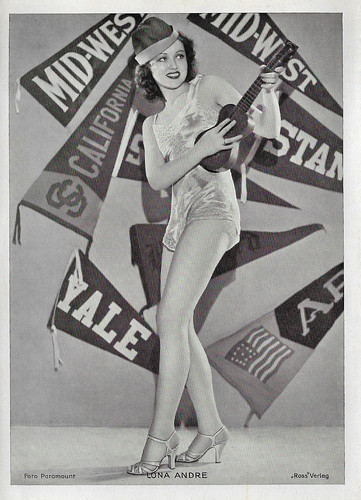
Big German card by Ross Verlag. Photo: Paramount.
Lona Andre (1915-1992) was an American film actress, golfer, and businesswoman. During the 1930s, she played in around 50 B-films. The major feature of the attractive actress was her cute dimples.
More, more, more? Check out our Flickr album Ross Verlag XXL.

Big German card by Ross Verlag. Photo: Paramount.
American actress and singer Dorothy Lamour (1914-1996) is best remembered for appearing in the Road to... comedies, starring Bing Crosby and Bob Hope. During World War II, Lamour was among the most popular pin-up girls among American servicemen.

Big German card by Ross Verlag. Photo: Ufa.
Maria von Tasnady (1911-2001) was a Hungarian singer, stage, and film actress.

Big German card by Ross Verlag. Photo: Paramount Pictures.
Blonde Mae West (1895-1982) was a seductive, overdressed, endearing, intelligent, and sometimes vulgar American actress and sex symbol. She featured a come-hither voice, aggressive sexuality, and a genius for comedy. West started in Vaudeville and on the stage in New York, and later moved to Hollywood to star in such films as I’m No Angel (1933), She Done Him Wrong (1933), and Klondike Annie (1936). She was one of the first women in the cinema to consistently write the films she starred in.

Big German card by Ross Verlag. Photo: Metro-Goldwyn-Mayer.
American actress Paulette Goddard (1905-1990) started her career as a fashion model and as a Ziegfeld Girl in several Broadway shows. In the 1940s, she became a major star of Paramount Pictures. She was Charlie Chaplin's leading lady in Modern Times (1936), and The Great Dictator. Goddard was nominated for an Oscar for Best Supporting Actress for So Proudly We Hail! (1943). Her husbands included Chaplin, Burgess Meredith, and Erich Maria Remarque.

Big German card by Ross Verlag. Photo: Paramount.
American film actress Carole Lombard (1908–1942) was the highest-paid star in Hollywood in the late 1930s. She was particularly noted for her energetic, ditzy, and often off-beat roles in screwball comedies of the 1930s.

Big German card by Ross Verlag. Photo: Paramount.
Marlene Dietrich (1901-1992) is regarded as the first German actress to become successful in Hollywood. Throughout her long career, she constantly re-invented herself, starting as a cabaret singer, chorus girl, and film actress in 1920s Berlin, she became a Hollywood movie star in the 1930s, a World War II frontline entertainer, and finally an international stage show performer from the 1950s to the 1970s. Eventually, she became one of the entertainment icons of the 20th century.

Big German card by Ross Verlag. Photo: Metro-Goldwyn-Mayer.
Lovely, blonde Muriel Evans (1910-2000) was an innocent-eyed actress of the late 1920s and 1930s She was best known for her many appearances in popular B-Westerns alongside Tom Mix, John Wayne, and Buck Jones. For this, she won a Golden Boot Award.

Big German card by Ross Verlag. Photo: Ernst Sandau, Berlin.
Polish film actress Pola Negri (1897-1987) achieved fame and notoriety as a femme fatale in German and American silent films between the 1910s and 1930s. Negri was an overnight sensation in Ernst Lubitsch's Madame du Barry/Passion (1919). She moved to Hollywood where she became a star and lived in a palace, modeled after the White House.

Big German card by Ross Verlag. Photo: Dührkoop.
Sexy German dancer and film actress La Jana (1905-1940) was the most popular showgirl of Berlin in the 1930s. She appeared in 25 European films, often dancing in exotic costumes. In 1940, she suddenly died of pneumonia and pleurisy.

Big German card by Ross Verlag. Photo: Paramount.
Ida Lupino (1918-1995) was an English-American actress and singer, who became a pioneering director and producer—the only woman working within the 1950s Hollywood studio system to do so. With her independent production company, she co-wrote and co-produced several of her own social-message films, and was the first woman to direct a Film Noir, The Hitch-Hiker (1953). In her 48-year career, she acted in 59 films and directed 8, mostly in the United States, where she became a citizen in 1948. The majority of her later career as an actress, writer, and director was in television, where she directed more than 100 episodes of productions ranging across Westerns, supernatural tales, situation comedies, murder mysteries, and gangster stories.

Big German card by Ross Verlag. Photo: Metro-Goldwyn-Mayer (MGM).
American actress Joan Crawford (1905-1977) became nationally-known as a flapper by the end of the 1920s. In the 1930s, her fame rivaled, and later outlasted, MGM colleagues Norma Shearer and Greta Garbo. Crawford often played hardworking young women who find romance and success. These 'rags-to-riches' stories were well received by Depression-era audiences and were popular with women. Crawford became one of Hollywood's most prominent movie stars and one of the highest-paid women in the United States, but her films began losing money and by the end of the 1930s she was labeled 'Box Office Poison'. But her career gradually improved in the early 1940s, and she made a major comeback in 1945 by starring in Mildred Pierce, for which she won the Academy Award for Best Actress.

Big German card by Ross Verlag. Photo: Paramount.
Lona Andre (1915-1992) was an American film actress, golfer, and businesswoman. During the 1930s, she played in around 50 B-films. The major feature of the attractive actress was her cute dimples.
More, more, more? Check out our Flickr album Ross Verlag XXL.
Published on February 05, 2021 22:00
February 4, 2021
Van Helsing (2004)
In the fantasy film Van Helsing (Stephen Sommers, 2004), Hugh Jackman plays the famed monster hunter. Van Helsing is sent by the Vatican to Transylvania to stop Count Dracula, (Richard Roxburgh) who is using Dr. Frankenstein's research and a werewolf for nefarious purposes. Whilst there they join forces with a Gypsy Princess called Anna Valerious (Kate Beckinsale), who is determined to end an ancient curse on her family by destroying the vampire.
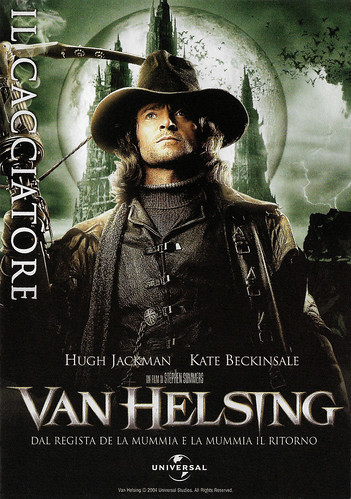
Italian postcard by Promocard, no. PC 4802. Photo: Universal. Hugh Jackman in Van Helsing (Stephen Sommers, 2004). The card was published for the video and DVD release of the film in Italy.
A tribute to Universal's classic Horror films
Universal produced Van Helsing (Stephen Sommers, 2004) as a homage and tribute to the Horror Monster films from the 1930s and 1940s, which were also produced by Universal Studios. Director is Stephen Sommers then known from The Mummy (1999), and its sequel, The Mummy Returns (2001). Sommers is a fan of Universal's horror films which were based on classic novels by Irish author Bram Stoker and by British Mary Shelley.
The character of Van Helsing was inspired by the Dutch vampire hunter Abraham Van Helsing from Bram Stoker's novel 'Dracula'. The film includes a number of monsters such as Count Dracula (and other Vampires), Frankenstein's monster, Duergar, Mr. Hyde and werewolves in a way similar to the multi-monster movies that Universal produced in the 1940s, such as Frankenstein Meets the Wolf Man (Roy William Neill, 1943), House of Frankenstein (Erle C. Kenton, 1944) and House of Dracula (Erle C. Kenton, 1945) with Lon Chaney Jr.
The film received mostly negative reviews. Jeremy Wheeler at AllMovie : "With a budget reportedly weighing in at a hefty 160 million dollars, Van Helsing is a bloated excuse for a crowd-pleaser whose excessive effects and humorless tone will undoubtedly suck the life out its audience long before the credits roll."
However, Roger Ebert of the Chicago Sun Times gave the film 3 stars out of 4: "The screenplay by Sommers has humor but restrains itself; the best touches are the quiet ones, as when the friar objects to accompanying Van Helsing ("But I'm not a field man," he insists) and when the Monster somewhat unexpectedly recites the 23rd Psalm. At the outset, we may fear Sommers is simply going for f/x overkill, but by the end, he has somehow succeeded in assembling all his monsters and plot threads into a high-voltage climax. Van Helsing is silly, spectacular and fun."
Despite the mostly negative reviews, Van Helsing (Stephen Sommers, 2004) earned $51 million at #1 during the opening weekend of 7-9 May 2004. The film eventually grossed US $300,257,475 worldwide.
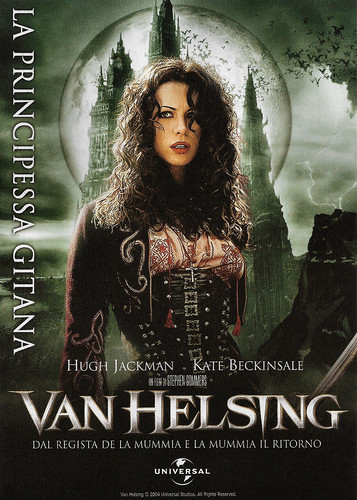
Italian postcard by Promocard, no. PC 4804. Photo: Universal. Kate Beckinsale in Van Helsing (Stephen Sommers, 2004). The card was published for the video and DVD release of the film in Italy.
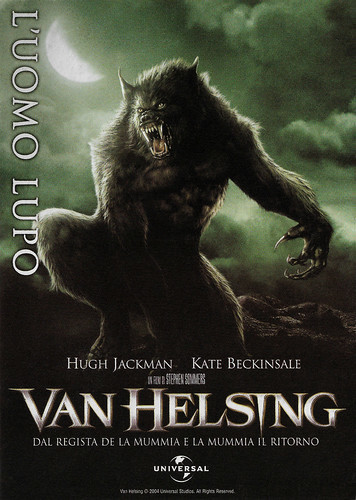
Italian postcard by Promocard, no. PC 4805. Photo: Universal. Hugh Jackman in Van Helsing (Stephen Sommers, 2004). The card was published for the video and DVD release of the film in Italy.
Sources: Jeremy Wheeler (AllMovie), Roger Ebert (Chicago Sun Times), Wikipedia and IMDb.

Italian postcard by Promocard, no. PC 4802. Photo: Universal. Hugh Jackman in Van Helsing (Stephen Sommers, 2004). The card was published for the video and DVD release of the film in Italy.
A tribute to Universal's classic Horror films
Universal produced Van Helsing (Stephen Sommers, 2004) as a homage and tribute to the Horror Monster films from the 1930s and 1940s, which were also produced by Universal Studios. Director is Stephen Sommers then known from The Mummy (1999), and its sequel, The Mummy Returns (2001). Sommers is a fan of Universal's horror films which were based on classic novels by Irish author Bram Stoker and by British Mary Shelley.
The character of Van Helsing was inspired by the Dutch vampire hunter Abraham Van Helsing from Bram Stoker's novel 'Dracula'. The film includes a number of monsters such as Count Dracula (and other Vampires), Frankenstein's monster, Duergar, Mr. Hyde and werewolves in a way similar to the multi-monster movies that Universal produced in the 1940s, such as Frankenstein Meets the Wolf Man (Roy William Neill, 1943), House of Frankenstein (Erle C. Kenton, 1944) and House of Dracula (Erle C. Kenton, 1945) with Lon Chaney Jr.
The film received mostly negative reviews. Jeremy Wheeler at AllMovie : "With a budget reportedly weighing in at a hefty 160 million dollars, Van Helsing is a bloated excuse for a crowd-pleaser whose excessive effects and humorless tone will undoubtedly suck the life out its audience long before the credits roll."
However, Roger Ebert of the Chicago Sun Times gave the film 3 stars out of 4: "The screenplay by Sommers has humor but restrains itself; the best touches are the quiet ones, as when the friar objects to accompanying Van Helsing ("But I'm not a field man," he insists) and when the Monster somewhat unexpectedly recites the 23rd Psalm. At the outset, we may fear Sommers is simply going for f/x overkill, but by the end, he has somehow succeeded in assembling all his monsters and plot threads into a high-voltage climax. Van Helsing is silly, spectacular and fun."
Despite the mostly negative reviews, Van Helsing (Stephen Sommers, 2004) earned $51 million at #1 during the opening weekend of 7-9 May 2004. The film eventually grossed US $300,257,475 worldwide.

Italian postcard by Promocard, no. PC 4804. Photo: Universal. Kate Beckinsale in Van Helsing (Stephen Sommers, 2004). The card was published for the video and DVD release of the film in Italy.

Italian postcard by Promocard, no. PC 4805. Photo: Universal. Hugh Jackman in Van Helsing (Stephen Sommers, 2004). The card was published for the video and DVD release of the film in Italy.
Sources: Jeremy Wheeler (AllMovie), Roger Ebert (Chicago Sun Times), Wikipedia and IMDb.
Published on February 04, 2021 22:00
February 3, 2021
Einar Zangenberg
Einar Zangenberg (1882-1918) was a Danish actor, film director, film producer, and a pioneer of Central European film. He was known as a dare-devil in early Danish silent cinema. As a swimmer, motorist, and even aviator he dazzled the audience. He soon spread his wings and moved to Berlin and Vienna. Only 35, Zangenberg died of the Spanish flu pandemic in Austria.
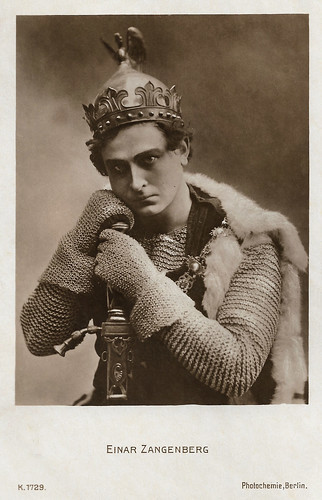
German postcard by Photochemie, no. K. 1729. Zangenberg wears the same outfit as on our card below. This refers to the Norwegian play 'Dronning Margaretha' (1834) by Adam Oehlenschläger.
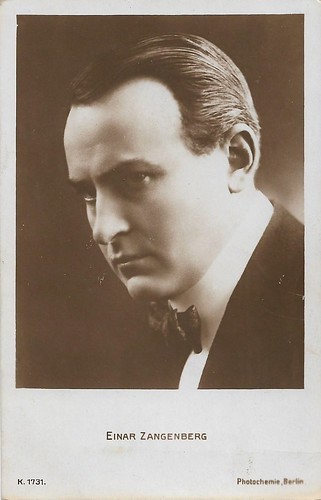
German postcard by Photochemie, no. K. 1731.
The first Danish film actor who could also fly an airplane
Einar Christian Constantin Zangenberg was born in 1882 in Copenhagen, Denmark. He was the son of the famous Danish stage actor Christian Zangenberg. Christian began his career at the Casino Theater in 1876 and joined the Royal Theatre five years later, where he remained until 1913
Einar Zangenberg received his stage training at the turn of the century at the Royal Theatre in his hometown and then performed at several private stages in the Danish capital.
In 1908, he made his film debut at Nordisk Film but did not really start until 1910, after which he quickly became one of the company's most used and prominent film stars.
Zangenberg was the first Danish film actor who could also fly an airplane - as well as drive, ride, and swim. Therefore he got various stunt roles in such films as En lektion/The aviator and the journalist's wife (August Blom, 1911), Den store flyver/The great flyer (Urban Gad, 1911), and En opfinders skæbne/The fate of an inventor (August Blom, 1912), in which he starred as a pilot ('aviator').
He played gallants and noblemen like Count Leo Zachochin in Dødsflugten (Einar Zangenberg, 1911) and von Plessen in Ungdommens ret/The right of youth (August Blom, 1911). In the adventurous sensational thriller Dr. Gar-el-Hama I: Bedraget i døden/A dead man's child (Eduard Schnedler-Sørensen, 1911), he hunts down the eponymous villain as the distinguished detective Newton.
In Millionobligationen/The Stolen Legacy (Director unknown 1911), he is an evil doctor unmasked by Sherlock Holmes ( Alwin Neuss ), while Zangenberg played Holmes himself in Hotelmysterierne/The Hotel Rats (Director unknown 1911). Already in 1908 he had played Holmes in Det Hemmelige Dokument/The Secret Document, one of the several Holmes films at Nordisk and directed by Viggo Larsen .
Often Einar Zangenberg was directed at Nordisk by August Blom, but surely not exclusively.
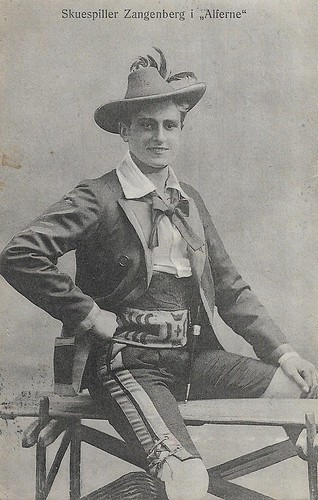
Danish postcard by Verdenspostforeningen. Mailed in 1906. Einar Zangenberg in the romantic folklore stage play 'Alferne' (The Elves, 1835) by Johan Ludvig Heiberg.
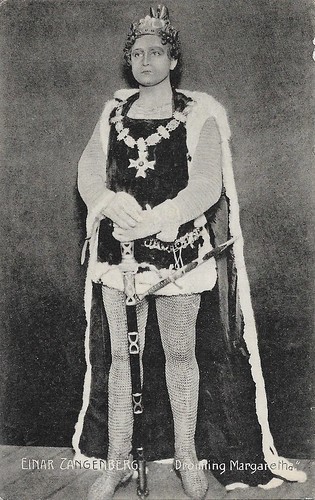
Danish postcard by C. St. Eneret, no. 4892. Einar Zangenberg in the Norwegian play 'Dronning Margaretha' (1834) by Adam Oehlenschläger. Sent in 1906. The part of Olaf in 'Dronning Margaretha' was already enacted by Zangenberg's father, Emil Zangenberg, and is considered the latter's best performance.
One of the countless victims of the notorious Spanish Flu
In 1912 Einar Zangenberg switched to the film company Kinografen, where he became director and artistic director. Until 1915, he both directed and participated in the company's films such as En Kvindes Ære/A woman's honour (1913), and Dødsklippen/The death rock (1913), both with Edith Buemann Psilander.
Shortly before the outbreak of the First World War, he joined the many Danish artists who left for Berlin, Germany, where he worked as a film director and actor. During the First World War, he directed a number of films for the companies PAGU and Flora-Film. Zangenberg himself co-starred with e.g. Trude Hesterberg and Hanni Weisse in these dramas and crime stories.
In 1917 Einar Zangenberg went to Vienna in order to produce Das Kind meines Nächsten/My neighbour's child (Einar Zangenberg, 1918), a top-level propaganda film for the welfare of war-damaged children. Empress Zita herself appeared in front of the camera, Zangenberg himself played the leading role.
With the A-Zet-Film, Einar Zangenberg also owned his own Austrian production company. At the end of April 1918, he left his by now established residence in Vienna.
Einar Zangenberg suddenly died in Vienna in 1918. He was only 35. German Wikipedia cites a 1918 obituary in the Neue Kino-Rundschau which stated he died in a sanatorium after a stomach operation. IMDb and Danish Wikipedia instead state that he was one of the countless victims of the notorious Spanish Flu.
All in all, Einar Zangenberg acted in 61 films and directed 32 films. Zangenberg was married to the actress Alfi Zangenberg (1882-1966), who had moved with him to Berlin and also starred in many of his films.
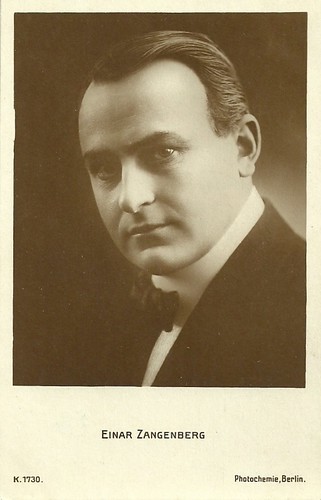
German postcard by Photochemie, Berlin, no. K. 1730.
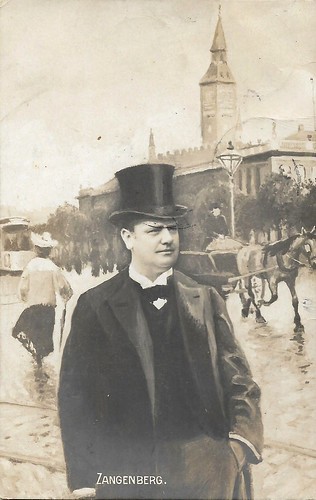
Danish postcard by Alex Vincent Konstforlag, Eneret, no. 516. Card sent in 1906. A painted portrait of Christian Zangenberg (1853-1914), a prominent actor of the Danish Royal Theatre and the father of Einar Zangenberg.
Sources: Wikipedia (German and Danish), and .

German postcard by Photochemie, no. K. 1729. Zangenberg wears the same outfit as on our card below. This refers to the Norwegian play 'Dronning Margaretha' (1834) by Adam Oehlenschläger.

German postcard by Photochemie, no. K. 1731.
The first Danish film actor who could also fly an airplane
Einar Christian Constantin Zangenberg was born in 1882 in Copenhagen, Denmark. He was the son of the famous Danish stage actor Christian Zangenberg. Christian began his career at the Casino Theater in 1876 and joined the Royal Theatre five years later, where he remained until 1913
Einar Zangenberg received his stage training at the turn of the century at the Royal Theatre in his hometown and then performed at several private stages in the Danish capital.
In 1908, he made his film debut at Nordisk Film but did not really start until 1910, after which he quickly became one of the company's most used and prominent film stars.
Zangenberg was the first Danish film actor who could also fly an airplane - as well as drive, ride, and swim. Therefore he got various stunt roles in such films as En lektion/The aviator and the journalist's wife (August Blom, 1911), Den store flyver/The great flyer (Urban Gad, 1911), and En opfinders skæbne/The fate of an inventor (August Blom, 1912), in which he starred as a pilot ('aviator').
He played gallants and noblemen like Count Leo Zachochin in Dødsflugten (Einar Zangenberg, 1911) and von Plessen in Ungdommens ret/The right of youth (August Blom, 1911). In the adventurous sensational thriller Dr. Gar-el-Hama I: Bedraget i døden/A dead man's child (Eduard Schnedler-Sørensen, 1911), he hunts down the eponymous villain as the distinguished detective Newton.
In Millionobligationen/The Stolen Legacy (Director unknown 1911), he is an evil doctor unmasked by Sherlock Holmes ( Alwin Neuss ), while Zangenberg played Holmes himself in Hotelmysterierne/The Hotel Rats (Director unknown 1911). Already in 1908 he had played Holmes in Det Hemmelige Dokument/The Secret Document, one of the several Holmes films at Nordisk and directed by Viggo Larsen .
Often Einar Zangenberg was directed at Nordisk by August Blom, but surely not exclusively.

Danish postcard by Verdenspostforeningen. Mailed in 1906. Einar Zangenberg in the romantic folklore stage play 'Alferne' (The Elves, 1835) by Johan Ludvig Heiberg.

Danish postcard by C. St. Eneret, no. 4892. Einar Zangenberg in the Norwegian play 'Dronning Margaretha' (1834) by Adam Oehlenschläger. Sent in 1906. The part of Olaf in 'Dronning Margaretha' was already enacted by Zangenberg's father, Emil Zangenberg, and is considered the latter's best performance.
One of the countless victims of the notorious Spanish Flu
In 1912 Einar Zangenberg switched to the film company Kinografen, where he became director and artistic director. Until 1915, he both directed and participated in the company's films such as En Kvindes Ære/A woman's honour (1913), and Dødsklippen/The death rock (1913), both with Edith Buemann Psilander.
Shortly before the outbreak of the First World War, he joined the many Danish artists who left for Berlin, Germany, where he worked as a film director and actor. During the First World War, he directed a number of films for the companies PAGU and Flora-Film. Zangenberg himself co-starred with e.g. Trude Hesterberg and Hanni Weisse in these dramas and crime stories.
In 1917 Einar Zangenberg went to Vienna in order to produce Das Kind meines Nächsten/My neighbour's child (Einar Zangenberg, 1918), a top-level propaganda film for the welfare of war-damaged children. Empress Zita herself appeared in front of the camera, Zangenberg himself played the leading role.
With the A-Zet-Film, Einar Zangenberg also owned his own Austrian production company. At the end of April 1918, he left his by now established residence in Vienna.
Einar Zangenberg suddenly died in Vienna in 1918. He was only 35. German Wikipedia cites a 1918 obituary in the Neue Kino-Rundschau which stated he died in a sanatorium after a stomach operation. IMDb and Danish Wikipedia instead state that he was one of the countless victims of the notorious Spanish Flu.
All in all, Einar Zangenberg acted in 61 films and directed 32 films. Zangenberg was married to the actress Alfi Zangenberg (1882-1966), who had moved with him to Berlin and also starred in many of his films.

German postcard by Photochemie, Berlin, no. K. 1730.

Danish postcard by Alex Vincent Konstforlag, Eneret, no. 516. Card sent in 1906. A painted portrait of Christian Zangenberg (1853-1914), a prominent actor of the Danish Royal Theatre and the father of Einar Zangenberg.
Sources: Wikipedia (German and Danish), and .
Published on February 03, 2021 22:00
February 2, 2021
Gustl Stark-Gstettenbauer
German stage, film, and television actor Gustl Stark-Gstettenbaur (1914-1996) or Gustl (Stark-)Gstettenbauer began his career onstage as a child actor in 1927, at the age of thirteen. He went on to play a variety of juvenile roles in German films during the late silent film era. Gstettenbaur's career continued as an adult on stage, in film, and on television.
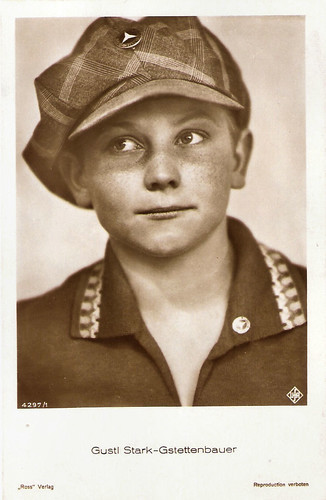
German postcard by Ross Verlag, no. 4297/1, 1929-1930. Photo: Ufa.
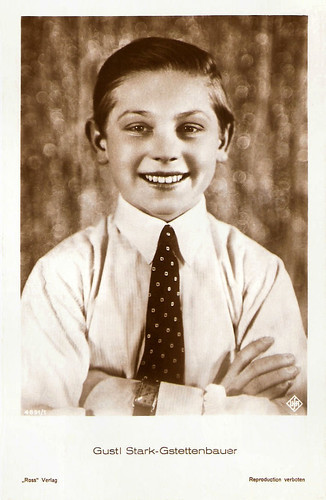
German postcard by Ross Verlag, no. 4691/1, 1929-1930. Sent by mail in 1930. Photo: Ufa.
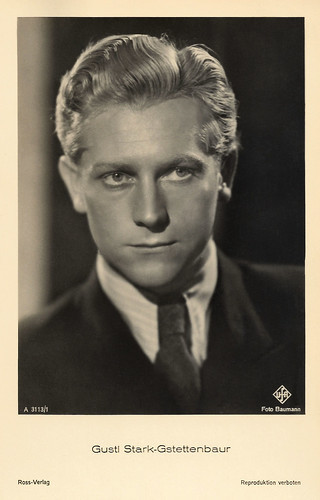
German postcard by Ross Verlag, no. A 3113/1, 1941-1944. Photo: Baumann / Ufa.
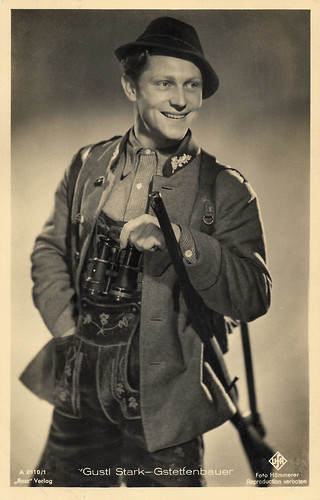
German postcard by Ross Verlag, no. A 2110/1, 1939-1940. Photo: Hämmerer / Ufa. Gustl Stark-Gstettenbaurin Der Edelweißkönig/King of the Edelweiss (Paul May, 1939).
Classics by Fritz Lang
August Ludwig Gstettenbaur was born in 1914 in Straubing, Germany. He was discovered for the stage by the actor Eugen Klöpfer.
Gustl had his first stage role at the age of 13 as Falstaff's page in 'Heinrich IV'(Henry IV) in the Lessing Theater in Berlin. He was best known for his portrayal of Piccolo Gustel in the popular operetta 'Im Weißen Rössl' (The White Horse Inn) by Ralph Benatzky.
One of his first film roles was in the silent comedy Der Piccolo vom Goldenen Löwen/The Page Boy at the Golden Lion (Carl Boese, 1928) starring Fritz Kampers.
Then followed a small part in the espionage thriller Spione/Spies (Fritz Lang, 1928) and a bigger one as a childish runaway in the classic Science Fiction film Frau im Mond/Woman in the Moon (Fritz Lang, 1930).
In 1930 he acted in the children's play 'Kakadu-Kakada' by Carl Zuckmayer in Berlin. The transition to the sound film was no problem. He soon became established as an actor for comedies.
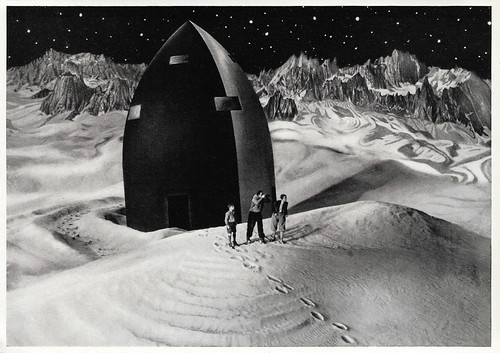
German collectors card by Ross Verlag in the series Vom Werden Deutscher Filmkunst - Der Stumme Film, picture no. 138, group 40. Photo: Ufa. Willy Fritsch , Gerda Maurus and Gustl Stark-Gstettenbauer in Frau im Mond/Woman in the Moon (Fritz Lang, 1929).
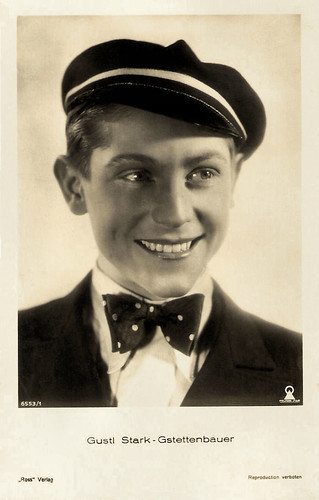
German postcard by Ross Verlag, no. 6553/1, 1931-1932. Photo: Felsom Film. Gustl Stark-Gstettenbaur in Mädchen zum Heiraten/Marry Me (Wilhelm Thiele, 1932).
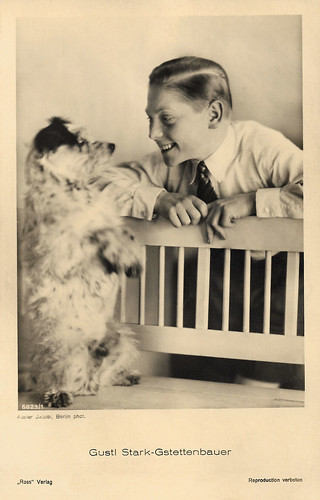
German postcard by Ross Verlag, no. 6823/1, 1931-1932. Photo: Atelier Jacobi, Berlin.
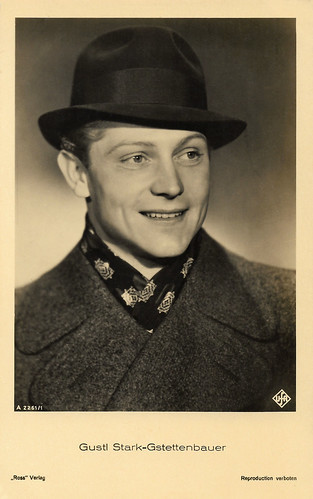
German postcard by Ross Verlag, no. A 2261/1, 1939-1940. Photo: Ufa.
Forest rangers, smugglers, hunters, etc.
With the advent of the sound film, Gustl Stark-Gstettenbaur's engagements at the theatres decreased, and the film came to the fore.
His film roles included Delikatessen/Delicatessen (Géza von Bolváry, 1930) with Harry Liedtke , Wien, du Stadt der Lieder/Vienna, you city of songs (Richard Oswald, 1930), Mädchen zum Heiraten/Girls to marry (Wilhelm Thiele, 1932) with Renate Müller , and Soldaten – Kameraden/Soldier comrades (Toni Huppertz, 1936).
Gstettenbaur continued his career after the Second World War, mainly in music and Heimat-films as forest rangers, smugglers, hunters, etc. In 1954 he played his one hundredth film role in the Austrian-German comedy Wenn ich einmal der Herrgott wär/If I were once God (Anton Kutter, 1954).
In the years from 1969 to 1971, he played in 5 episodes of the series Königlich Bayerisches Amtsgericht/The Royal Bavarian District Court. For several years Gustl Gstettenbaur ran a guest house with a café in Hindelang / Allgäu under the name 'Filmstüberl "Bei Gustl"'.
In 1985 he received the Filmband in Gold award for his many years of outstanding work in the German cinema. Gustl Stark-Gstettenbaur died in 1996 in Bad Hindelang, Bavaria, Germany. He was 82. He was married to Gracie Schenk.
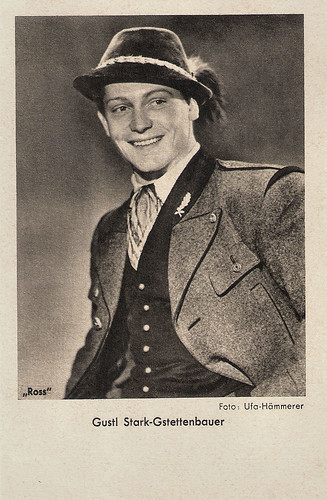
German postcard by Ross Verlag for Das Programm von Heute, Berlin. Photo: Hämmerer / Ufa.
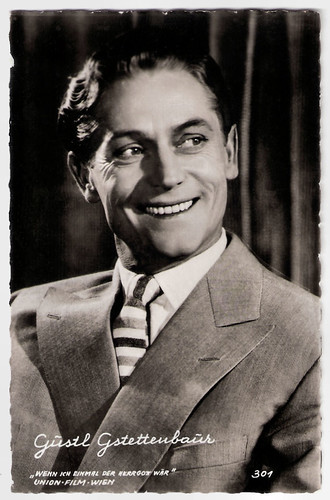
Austrian postcard by Verlag Hubmann, Wien (HDH Verlag), no. 301. Photo: Union-Film, Wien. Gustl Stark-Gstettenbauer in Wenn ich einmal der Herrgott wär/If I Could Be God Just Once See (Anton Kutter, 1954).
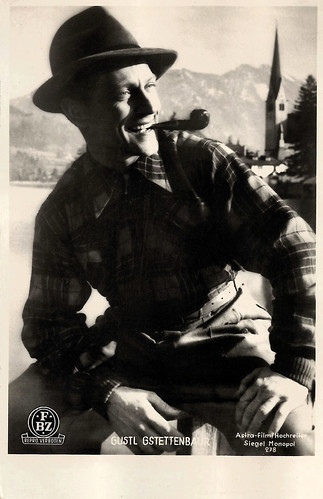
West-German postcard by F.B.Z., no. 278. Photo: Astra-Film / Hochreiter / Siegel / Monopol.
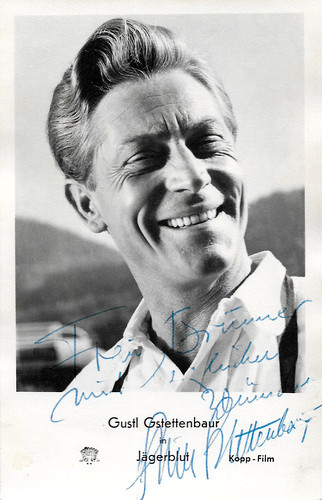
German postcard by Klei. Photo: König Film / Kopp-Film. Gustl Stark-Gstettenbaur in Jägerblut/Hunter's blood (Hans H. König, 1957).
Sources: Wikipedia and .

German postcard by Ross Verlag, no. 4297/1, 1929-1930. Photo: Ufa.

German postcard by Ross Verlag, no. 4691/1, 1929-1930. Sent by mail in 1930. Photo: Ufa.

German postcard by Ross Verlag, no. A 3113/1, 1941-1944. Photo: Baumann / Ufa.

German postcard by Ross Verlag, no. A 2110/1, 1939-1940. Photo: Hämmerer / Ufa. Gustl Stark-Gstettenbaurin Der Edelweißkönig/King of the Edelweiss (Paul May, 1939).
Classics by Fritz Lang
August Ludwig Gstettenbaur was born in 1914 in Straubing, Germany. He was discovered for the stage by the actor Eugen Klöpfer.
Gustl had his first stage role at the age of 13 as Falstaff's page in 'Heinrich IV'(Henry IV) in the Lessing Theater in Berlin. He was best known for his portrayal of Piccolo Gustel in the popular operetta 'Im Weißen Rössl' (The White Horse Inn) by Ralph Benatzky.
One of his first film roles was in the silent comedy Der Piccolo vom Goldenen Löwen/The Page Boy at the Golden Lion (Carl Boese, 1928) starring Fritz Kampers.
Then followed a small part in the espionage thriller Spione/Spies (Fritz Lang, 1928) and a bigger one as a childish runaway in the classic Science Fiction film Frau im Mond/Woman in the Moon (Fritz Lang, 1930).
In 1930 he acted in the children's play 'Kakadu-Kakada' by Carl Zuckmayer in Berlin. The transition to the sound film was no problem. He soon became established as an actor for comedies.

German collectors card by Ross Verlag in the series Vom Werden Deutscher Filmkunst - Der Stumme Film, picture no. 138, group 40. Photo: Ufa. Willy Fritsch , Gerda Maurus and Gustl Stark-Gstettenbauer in Frau im Mond/Woman in the Moon (Fritz Lang, 1929).

German postcard by Ross Verlag, no. 6553/1, 1931-1932. Photo: Felsom Film. Gustl Stark-Gstettenbaur in Mädchen zum Heiraten/Marry Me (Wilhelm Thiele, 1932).

German postcard by Ross Verlag, no. 6823/1, 1931-1932. Photo: Atelier Jacobi, Berlin.

German postcard by Ross Verlag, no. A 2261/1, 1939-1940. Photo: Ufa.
Forest rangers, smugglers, hunters, etc.
With the advent of the sound film, Gustl Stark-Gstettenbaur's engagements at the theatres decreased, and the film came to the fore.
His film roles included Delikatessen/Delicatessen (Géza von Bolváry, 1930) with Harry Liedtke , Wien, du Stadt der Lieder/Vienna, you city of songs (Richard Oswald, 1930), Mädchen zum Heiraten/Girls to marry (Wilhelm Thiele, 1932) with Renate Müller , and Soldaten – Kameraden/Soldier comrades (Toni Huppertz, 1936).
Gstettenbaur continued his career after the Second World War, mainly in music and Heimat-films as forest rangers, smugglers, hunters, etc. In 1954 he played his one hundredth film role in the Austrian-German comedy Wenn ich einmal der Herrgott wär/If I were once God (Anton Kutter, 1954).
In the years from 1969 to 1971, he played in 5 episodes of the series Königlich Bayerisches Amtsgericht/The Royal Bavarian District Court. For several years Gustl Gstettenbaur ran a guest house with a café in Hindelang / Allgäu under the name 'Filmstüberl "Bei Gustl"'.
In 1985 he received the Filmband in Gold award for his many years of outstanding work in the German cinema. Gustl Stark-Gstettenbaur died in 1996 in Bad Hindelang, Bavaria, Germany. He was 82. He was married to Gracie Schenk.

German postcard by Ross Verlag for Das Programm von Heute, Berlin. Photo: Hämmerer / Ufa.

Austrian postcard by Verlag Hubmann, Wien (HDH Verlag), no. 301. Photo: Union-Film, Wien. Gustl Stark-Gstettenbauer in Wenn ich einmal der Herrgott wär/If I Could Be God Just Once See (Anton Kutter, 1954).

West-German postcard by F.B.Z., no. 278. Photo: Astra-Film / Hochreiter / Siegel / Monopol.

German postcard by Klei. Photo: König Film / Kopp-Film. Gustl Stark-Gstettenbaur in Jägerblut/Hunter's blood (Hans H. König, 1957).
Sources: Wikipedia and .
Published on February 02, 2021 22:00
February 1, 2021
Umberto Melnati
Though he also had various parts in dramas and precursors of the Giallo, Umberto Melnati (1897-1979) is mostly known for his screen comedies, in particular, the 'Telefoni Bianchi' comedies of the 1930s and 1940s. In these films, he often acted with Vittorio De Sica (Due cuori felici, Il signor Max, etc.), and Alida Valli (Mille lire al mese). Before, he had acted on stage with De Sica and Checco Rissone. After the war, Melnati played the lead in the film drama La valigia dei sogni (1953) by Luigi Comencini. He appeared in over 35 films between 1932 and 1962.
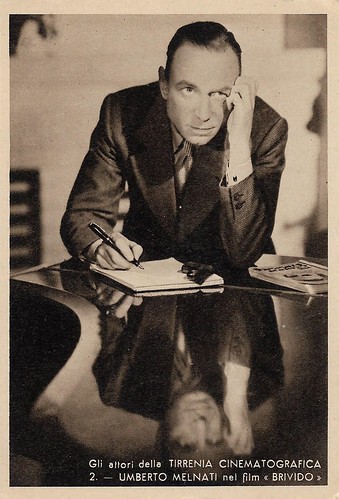
Italian postcard by Unione Fotoincisori Firenze. Photo: Gneme / Prod. INCINE. Caption: The actors of the Tirrenia film studio, no. 2. Umberto Melnati in the film Brivido (Giacomo Gentilomo, 1941).
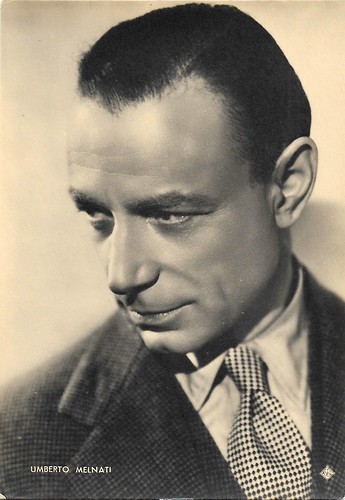
Italian postcard by ASER (A. Scarmiglia Ed., Roma). Photo: Gneme.
An unmistakable shrill and slightly nasal voice
Umberto Melnati was born in Livorno (Leghorn), Italy, in 1897. His real name was Raimundo Melnati, and he was the son of the actors Gino Pietro and Marcella Conti.
He specialised at a very young age in the role of supporting actor on stage. During the First World War, he was a generic actor in various companies until joining the company of Alfredo De Sanctis in 1919.
In 1931 he entered into a company with Vittorio De Sica and Giuditta Rissone and together they participated in 'Za Bum n. 8 and n. 10'. It was in the famous revues produced by Luciano Ramo and Mario Mattoli, such as 'Lucciole della città' (Falconi and Biancoli, 1931), that the famous duets ("Düra minga") between Melnati and De Sica matured, promptly exported to the radio universe within of the programs "offered by".
In 1938 he interpreted the Touchstone in 'As you like it' by William Shakespeare, directed by Jacques Copeau, and with actors Massimo Pianforini, Enzo Biliotti, and others at the Boboli Gardens in Florence.
The trio De Sica-Melnati-Rissone enjoyed enormous success for a decade, also thanks to the records and sketches taken from the magazines that the protagonists recorded for Dischi Columbia and which were then also broadcast on radio, and added to the theatrical activity that cinema and radio (the first episode of radio skits for the Bisleri liquor company in 1937).
Melnati's success was immediately linked to an unmistakable shrill and slightly nasal voice that the actor emphasised in the contrasting singing duo with his friend De Sica or by dubbing the character actors in the films of the time. Melnati was also one of the first actors employed by RAI in their first works of fiction: in 1958, when the state broadcaster had been broadcasting for only four years, he was among the interpreters of the television program Il Teatro dei Ragazzi which proposed scripted stories for children and adolescents.
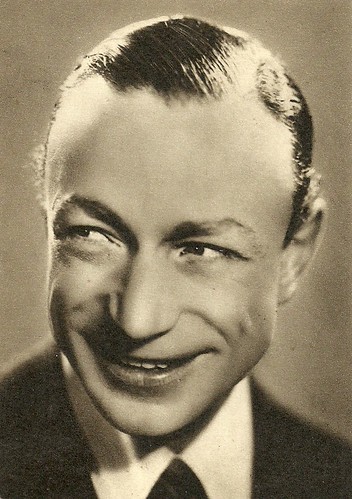
Italian postcard by Melloni. Photo: Luxardo.
A brilliant actor with a nervous acting style
Umberto Melnati became well-known in Italy in the mid-1930s thanks to some famous parts in the cinema. His film debut was Due cuori felici (Baldassarre Negroni, 1932) with Vittorio De Sica and Rina Franchetti. Then followed L'uomo che sorride (Mario Mattoli, 1936) with De Sica and Assia Noris , Il signor Max (Mario Camerini, 1937) with De Sica, Noris and Rubi Dalma , and Mille lire al mese (Max Neufeld, 1938) with Alida Valli and Osvaldo Valenti.
In the early 1940s, he acted in La peccatrice (Amleto Palermi, 1940) starring Paola Barbara , and the pre-Giallo Cortocircuito (Giacomo Gentilomo, 1943) with Vivi Gioi . Between 1932 and 1943 Melnati acted with De Sica in well nine films, plus several with Assia Noris .
After the war, Umberto Melnati returned to the stage revues alongside the most famous faces of the time (De Sica, Elsa Merlini , Isa Pola , Milly), not disdaining more demanding interpretations. By now, however, the artist was definitively attracted by the mass media and by a consolidated radio career: among the numerous others, one can remember his participation in the radio comedies 'Non ti conosco più' (1950) and 'Buonanotte, Patrizia' (1960), both directed by Umberto Benedetto.
In addition, he had success in some comedies broadcast on television, such as Zampa di velluto, Milizia territoriale, Jack l'infallibile, and La moglie di papà.
From 1950 Melnati returned to the film sets for 10 more parts. Melnati's best post-war film interpretation, which aimed more at the pathetic than the comedian, remains that of the old film actor who survives by saving and projecting the great masterpieces of Italian silent cinema in private parties, in the film La valigia dei sogni (1953) by Luigi Comencini.
Melnati was a brilliant actor with a nervous acting style. He often had a convulsive speech that made his jokes and theatrical and radio monologues a success. He embodied the triumph of the light radio show, made up of improvisations and short-term interventions that exerted so much attraction on the listener of the time. As he remembers in his memoirs 'Così... per ridere' (1954), his radio interventions were often just "small talk" adapted from repertoire jokes that the actor developed into radio talks of about ten minutes.
Umberto Melnati was married to Christie Cleyn. He died in 1979 in Rome. He was 81.
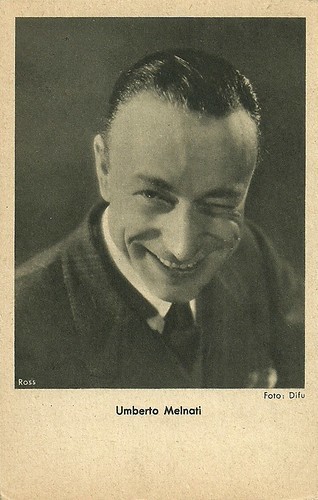
German postard by Ross. Photo: Difu.
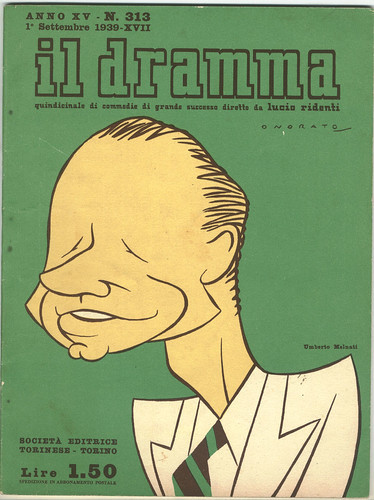
Cover of the magazine Il Dramma, no. 313, 1939. Caricature of Umberto Melnati by Onorato. Collection: Manuel Palomino Arjona (Flickr).
Sources: Wikipedia (Italian and English), and .

Italian postcard by Unione Fotoincisori Firenze. Photo: Gneme / Prod. INCINE. Caption: The actors of the Tirrenia film studio, no. 2. Umberto Melnati in the film Brivido (Giacomo Gentilomo, 1941).

Italian postcard by ASER (A. Scarmiglia Ed., Roma). Photo: Gneme.
An unmistakable shrill and slightly nasal voice
Umberto Melnati was born in Livorno (Leghorn), Italy, in 1897. His real name was Raimundo Melnati, and he was the son of the actors Gino Pietro and Marcella Conti.
He specialised at a very young age in the role of supporting actor on stage. During the First World War, he was a generic actor in various companies until joining the company of Alfredo De Sanctis in 1919.
In 1931 he entered into a company with Vittorio De Sica and Giuditta Rissone and together they participated in 'Za Bum n. 8 and n. 10'. It was in the famous revues produced by Luciano Ramo and Mario Mattoli, such as 'Lucciole della città' (Falconi and Biancoli, 1931), that the famous duets ("Düra minga") between Melnati and De Sica matured, promptly exported to the radio universe within of the programs "offered by".
In 1938 he interpreted the Touchstone in 'As you like it' by William Shakespeare, directed by Jacques Copeau, and with actors Massimo Pianforini, Enzo Biliotti, and others at the Boboli Gardens in Florence.
The trio De Sica-Melnati-Rissone enjoyed enormous success for a decade, also thanks to the records and sketches taken from the magazines that the protagonists recorded for Dischi Columbia and which were then also broadcast on radio, and added to the theatrical activity that cinema and radio (the first episode of radio skits for the Bisleri liquor company in 1937).
Melnati's success was immediately linked to an unmistakable shrill and slightly nasal voice that the actor emphasised in the contrasting singing duo with his friend De Sica or by dubbing the character actors in the films of the time. Melnati was also one of the first actors employed by RAI in their first works of fiction: in 1958, when the state broadcaster had been broadcasting for only four years, he was among the interpreters of the television program Il Teatro dei Ragazzi which proposed scripted stories for children and adolescents.

Italian postcard by Melloni. Photo: Luxardo.
A brilliant actor with a nervous acting style
Umberto Melnati became well-known in Italy in the mid-1930s thanks to some famous parts in the cinema. His film debut was Due cuori felici (Baldassarre Negroni, 1932) with Vittorio De Sica and Rina Franchetti. Then followed L'uomo che sorride (Mario Mattoli, 1936) with De Sica and Assia Noris , Il signor Max (Mario Camerini, 1937) with De Sica, Noris and Rubi Dalma , and Mille lire al mese (Max Neufeld, 1938) with Alida Valli and Osvaldo Valenti.
In the early 1940s, he acted in La peccatrice (Amleto Palermi, 1940) starring Paola Barbara , and the pre-Giallo Cortocircuito (Giacomo Gentilomo, 1943) with Vivi Gioi . Between 1932 and 1943 Melnati acted with De Sica in well nine films, plus several with Assia Noris .
After the war, Umberto Melnati returned to the stage revues alongside the most famous faces of the time (De Sica, Elsa Merlini , Isa Pola , Milly), not disdaining more demanding interpretations. By now, however, the artist was definitively attracted by the mass media and by a consolidated radio career: among the numerous others, one can remember his participation in the radio comedies 'Non ti conosco più' (1950) and 'Buonanotte, Patrizia' (1960), both directed by Umberto Benedetto.
In addition, he had success in some comedies broadcast on television, such as Zampa di velluto, Milizia territoriale, Jack l'infallibile, and La moglie di papà.
From 1950 Melnati returned to the film sets for 10 more parts. Melnati's best post-war film interpretation, which aimed more at the pathetic than the comedian, remains that of the old film actor who survives by saving and projecting the great masterpieces of Italian silent cinema in private parties, in the film La valigia dei sogni (1953) by Luigi Comencini.
Melnati was a brilliant actor with a nervous acting style. He often had a convulsive speech that made his jokes and theatrical and radio monologues a success. He embodied the triumph of the light radio show, made up of improvisations and short-term interventions that exerted so much attraction on the listener of the time. As he remembers in his memoirs 'Così... per ridere' (1954), his radio interventions were often just "small talk" adapted from repertoire jokes that the actor developed into radio talks of about ten minutes.
Umberto Melnati was married to Christie Cleyn. He died in 1979 in Rome. He was 81.

German postard by Ross. Photo: Difu.

Cover of the magazine Il Dramma, no. 313, 1939. Caricature of Umberto Melnati by Onorato. Collection: Manuel Palomino Arjona (Flickr).
Sources: Wikipedia (Italian and English), and .
Published on February 01, 2021 22:00
Paul van Yperen's Blog
- Paul van Yperen's profile
- 13 followers
Paul van Yperen isn't a Goodreads Author
(yet),
but they
do have a blog,
so here are some recent posts imported from
their feed.



